The Ultimate 1-Week Tunisia Itinerary for First-Time Visitors
It’s weird being a travel blogger. One moment you’re at a networking event in London, and the next, you’re onboard a flight to Tunisia to attend a sustainability conference and explore the Sahara desert.
Random and last-minute as it was, the trip was amazing (I still have trouble believing that this is my job sometimes), and now that I’m back home, I want to share all of my recommendations with you.
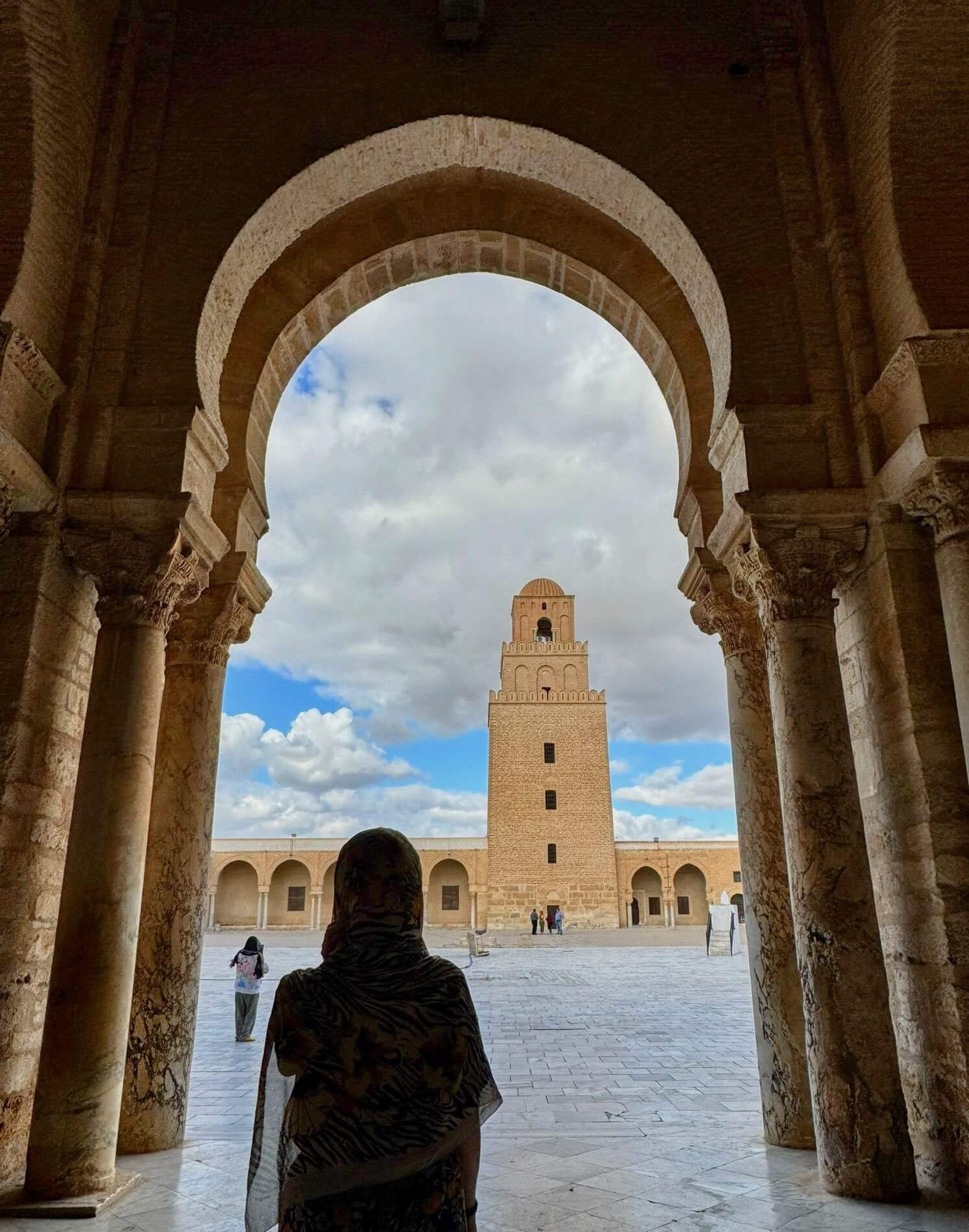
So, if you’re planning 1 week in Tunisia and are wondering what to include on your Tunisia itinerary, I’ve got you.
Here’s how to spend 7 days in Tunisia.
The Ultimate 1-Week Tunisia Itinerary
Tunisia at a glance
Ask most people what they think of when they picture Tunisia, and they’ll talk about beach resorts and all-inclusive hotels.
In fact, before the 2015 terror attacks in Sousse and Tunis, Tunisia was one of the most popular destinations for Brits trying to escape the miserable English weather.
Naturally, after the tragic events of 2015, tourism in Tunisia took a nosedive, and things are only just beginning to pick up.
However, rather than flocking to Tunisia’s famous beach resorts, more and more tourists are seeking out deeper, more authentic experiences.
Ever wondered what it would be like to ride a camel in the Sahara desert? What about taking a cooking class in a local’s home, learning how to make traditional Tunisian carpets, or visiting mosques and archaeological sites?
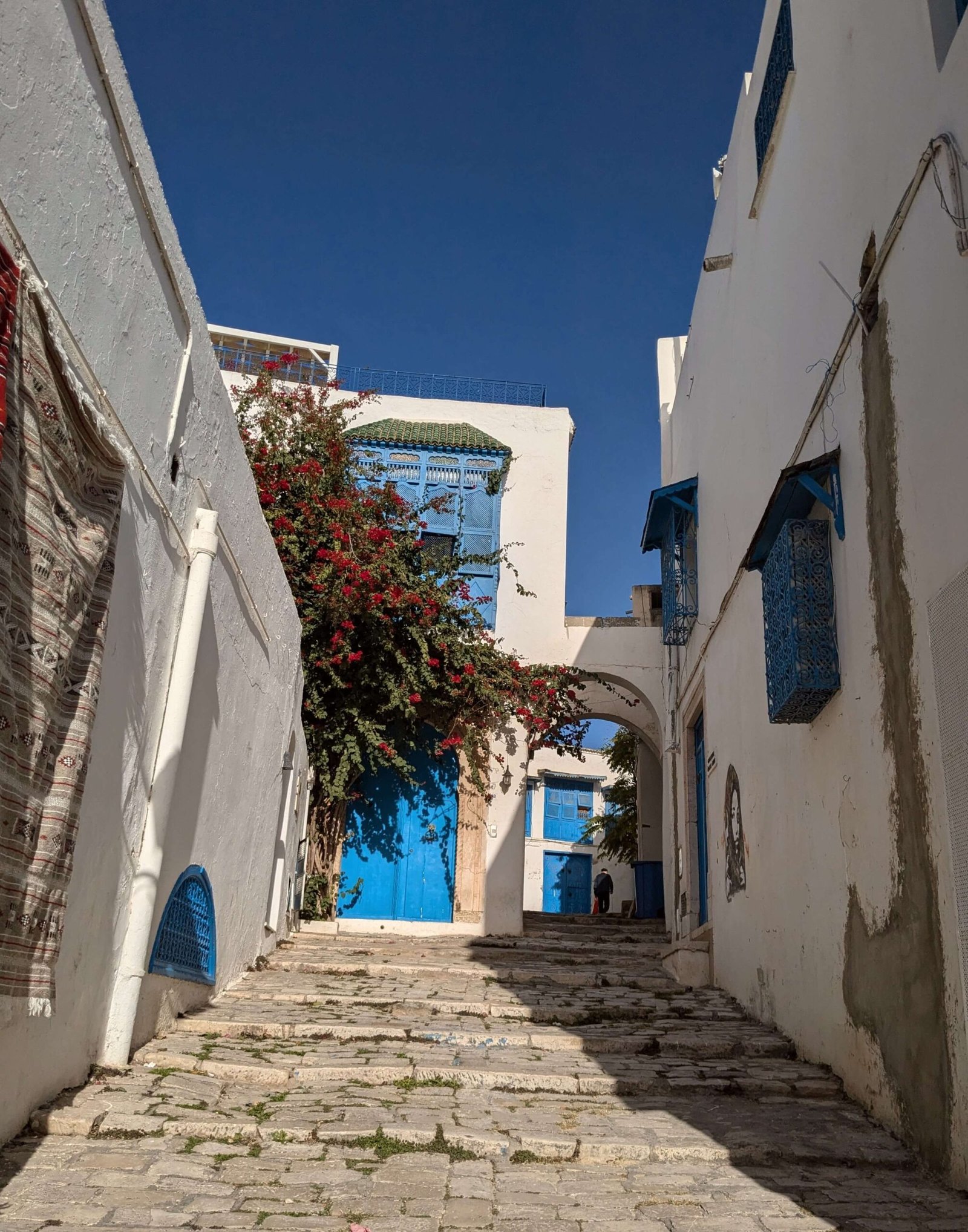
These authentic local experiences are what I’m going to share with you in my Tunisia itinerary, so if they sound good to you, just keep reading.
Facts about Tunisia
Before I share my Tunisia itinerary with you, it’s worth taking a note of the basics.
Here are some Tunisia facts that you should definitely know before you go:
- Location: North Africa.
- Capital: Tunis.
- Language: Tunisian Arabic, Classical Arabic, and French. Many people also speak English.
- Population: 12 million
- Currency: Tunisian Dinar. 1 TND is 0.25 GBP or 0.30 EUR. The Tunisian Dinar is a closed currency. That means it’s illegal to bring it into or out of the country. In fact, you can’t even pay in Dinar at the airport, so make sure you get rid of all your cash before the end of your trip!
- Time Zone: Tunisia observes Central European Time all year.
- Religion: Tunisia is an Islamic country, with 98.2% of the population practicing Sunni Islam.
7-Day Tunisia Itinerary
Day 1: Arrival in Tunis
Tunis is the capital of Tunisia, and it’s one of the most laid back capitals I’ve ever visited.
Morning: Medina of Tunis
The Medina of Tunis is a UNESCO World Heritage site, and is where you’ll be able to soak up the culture, get lost in the narrow alleyways, and practice your bargaining skills in the souks.
Popular souvenirs to buy in Tunisia include olive oil, dates, silver jewellery, ‘desert roses,’ leather goods, ceramics, and traditional Tunisian carpets.
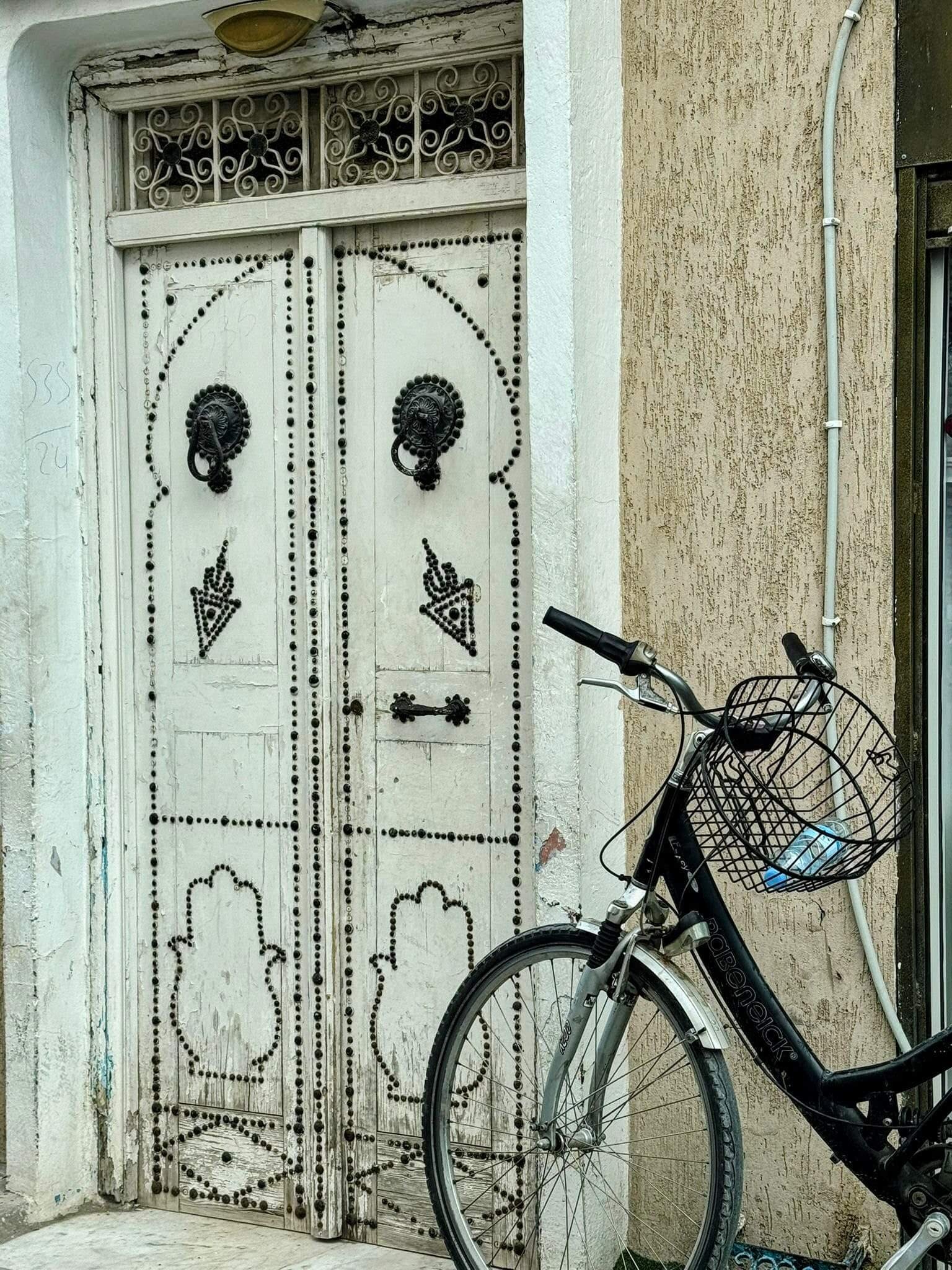
Afternoon: Centre of Tunis
After you’ve explored the Medina, take a stroll down the tree-lined Habib-Bourguiba, which was inspired by the Champs-Élysées in Paris.
Admire the French Colonial architecture, take a photo of the Tunis Clock Tower (Google Maps link), and enjoy a coffee and pastry at one of the many cafes that line the street (although do check their ratings on Google Maps before you settle on one, as a few have bad reviews).
Pro tip: If you don’t have a full day, or you just want to get as much out of your time in Tunis as possible, I recommend booking a guided tour.
This 3-hour tour with a professional guide includes both the Medina and the city centre, as well as coffee or tea.
Key sights in Tunis:
- Medina of Tunis
- Habib-Bourguiba
- Tunis Clock Tower
- Zitouna Mosque
- Dar Lasram (19th century mansion)
- Zaouia of Sidi Ben Arous (16th century mausoleum)
Where to stay in Tunis
I stayed at the 5-Star Hotel Africa, which was situated right on Habib-Bourguiba, close to the clock tower, and I can definitely recommend it.
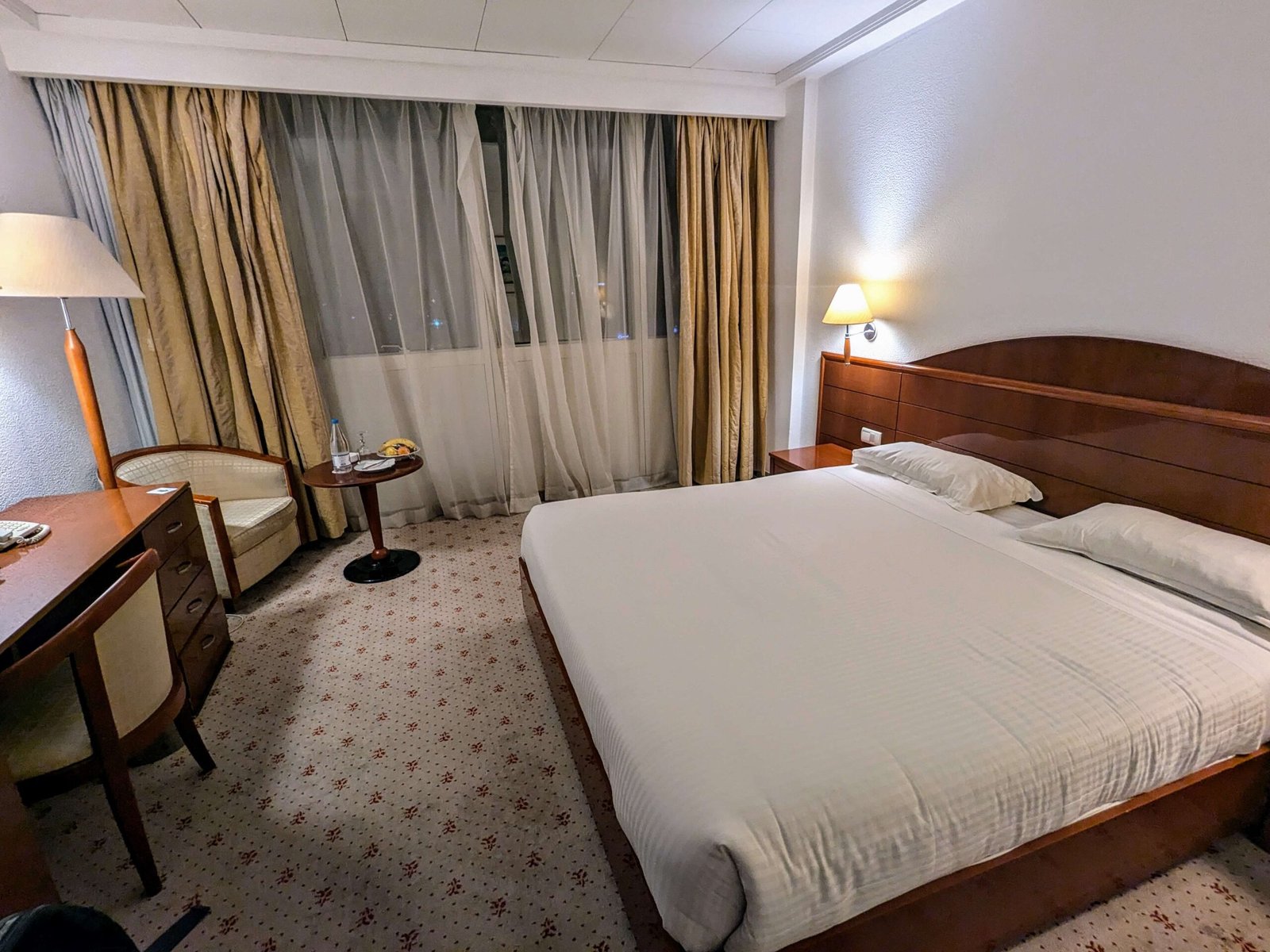
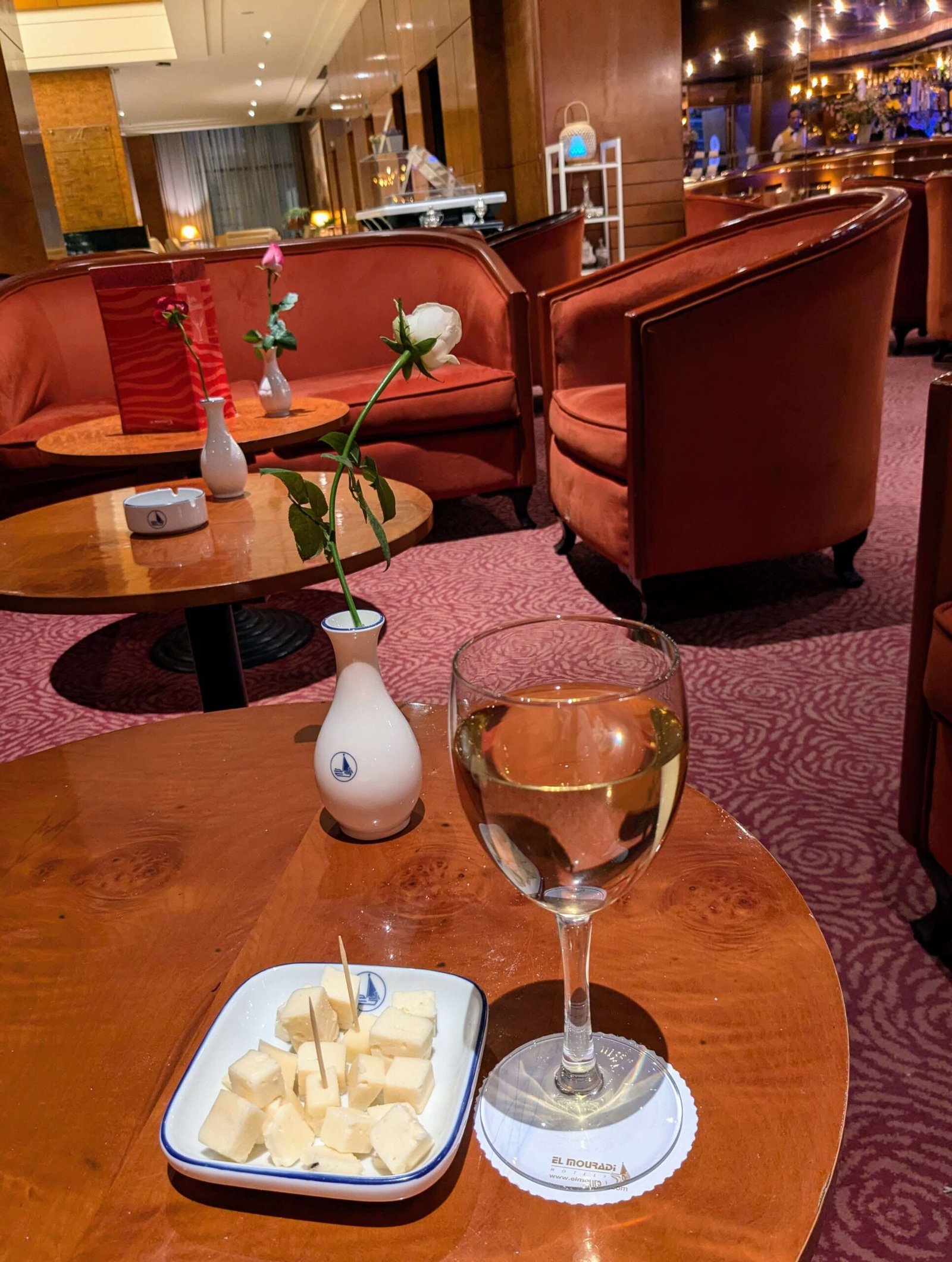
While the rooms were basic, they had everything you need for a comfortable nights’ sleep, and I really liked the lobby bar and the buffet breakfast.
I also had lovely views over the city from my room, and was shocked when I woke up and realised I could see the sea!
Day 2: Tunis to Tozeur (via Kairouan)
Today you have a long drive ahead of you, because you’re heading to Tozeur!
The total drive takes about 6/7 hours, but to keep things a little more interesting, we’re going to stop in Kairouan, Tunisia’s holiest city.
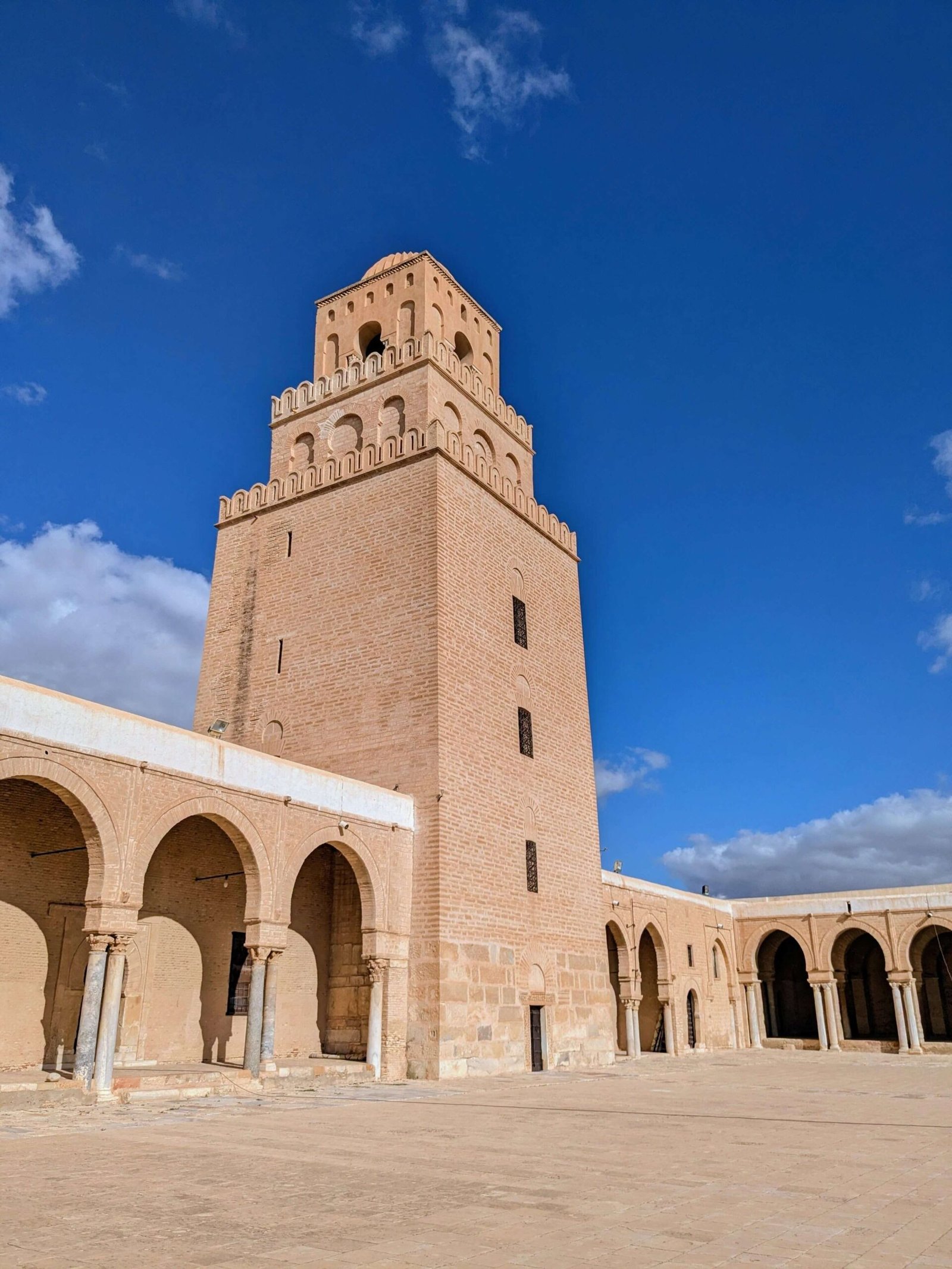
Morning: Tunis to Kairouan
Enjoy breakfast at your hotel before making the 2-hour journey to Kairouan. I recommend leaving between 8-9am.
The quickest and most affordable way to travel in Tunisia is by shared taxi/minibus. This is called a louage, and the louage network is spread all across the country.
The way it works is simple – you head to the city’s louage station and find the vehicle that is heading to where you want to go. You pay the driver the set fare, take a seat, and wait for the vehicle to fill up. As soon as it does, you’ll be on your way!
Of course, this could mean you’ll be waiting around for a while, but louages tend to fill up every few minutes, and are actually considered more reliable than trains in Tunisia.
I found a great and in-depth guide to using louages here.
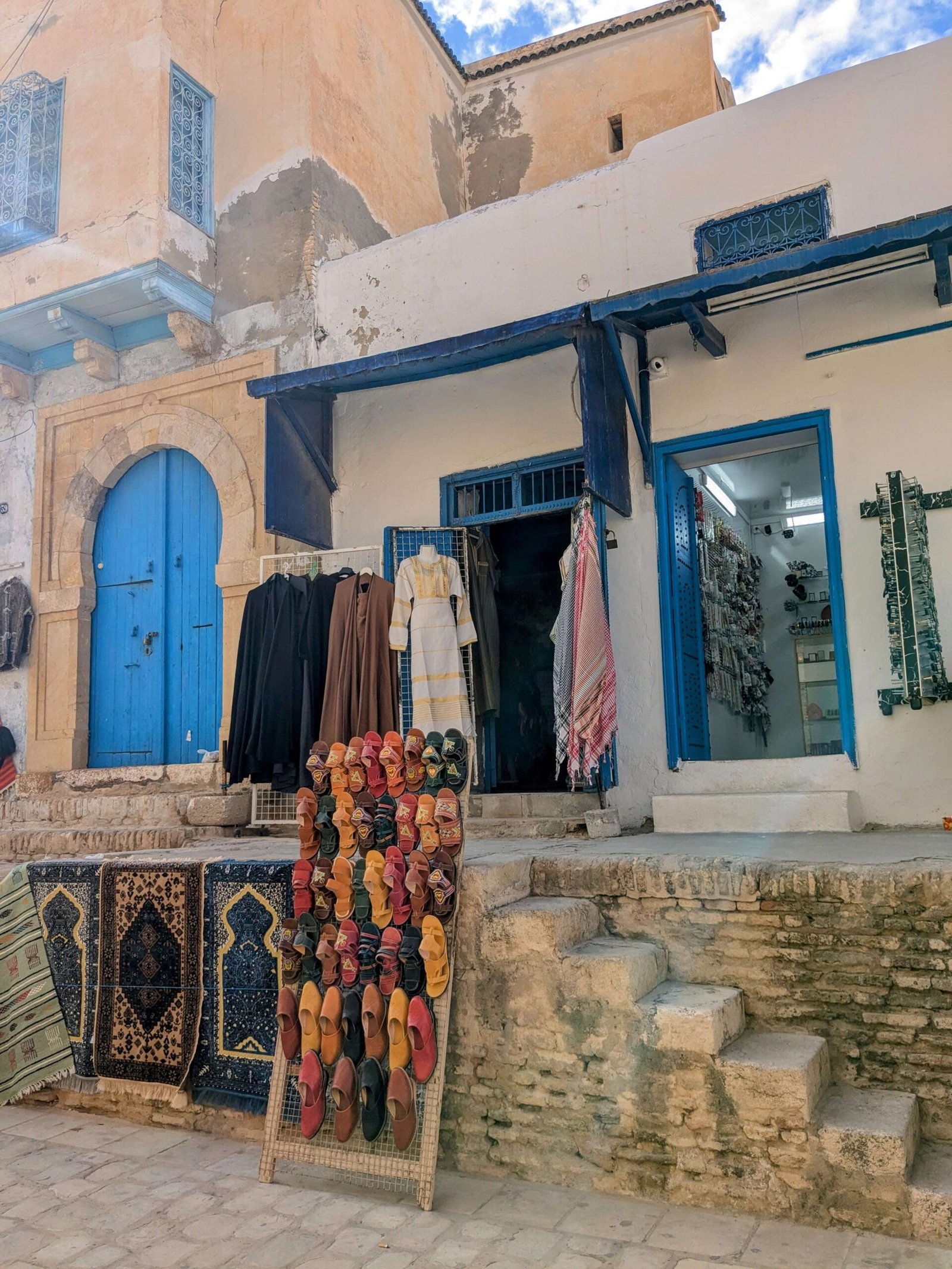
Afternoon: Explore Kairouan
The UNESCO World Heritage Site of Kairouan is the holiest city in Tunisia (as of 2004, there were 89 mosques in Kairouan!) and the fourth holiest city in Islam after Mecca, Medina, and Jerusalem.
Take some time to wander through the Medina before heading to the Great Mosque of Kairouan.
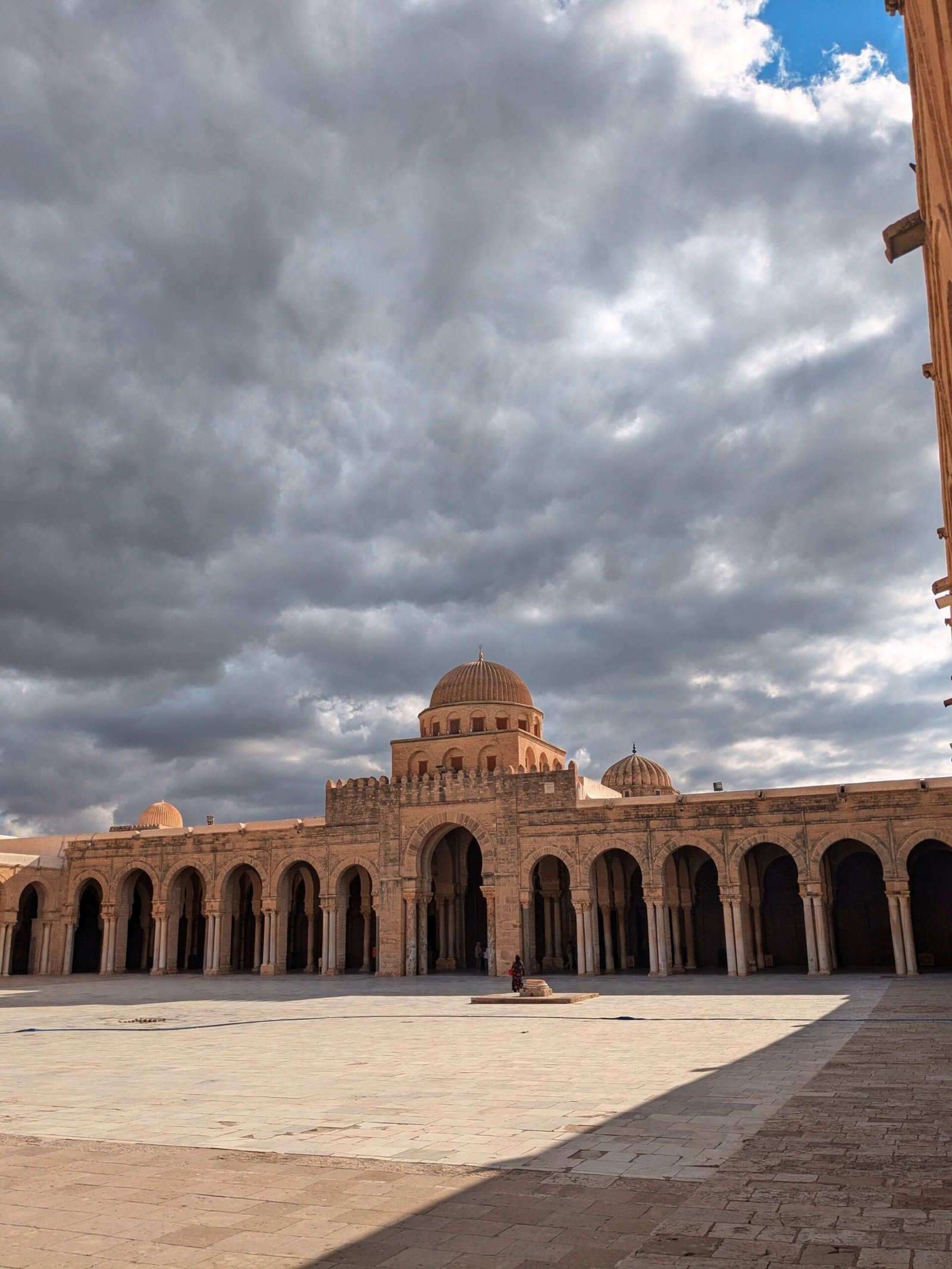
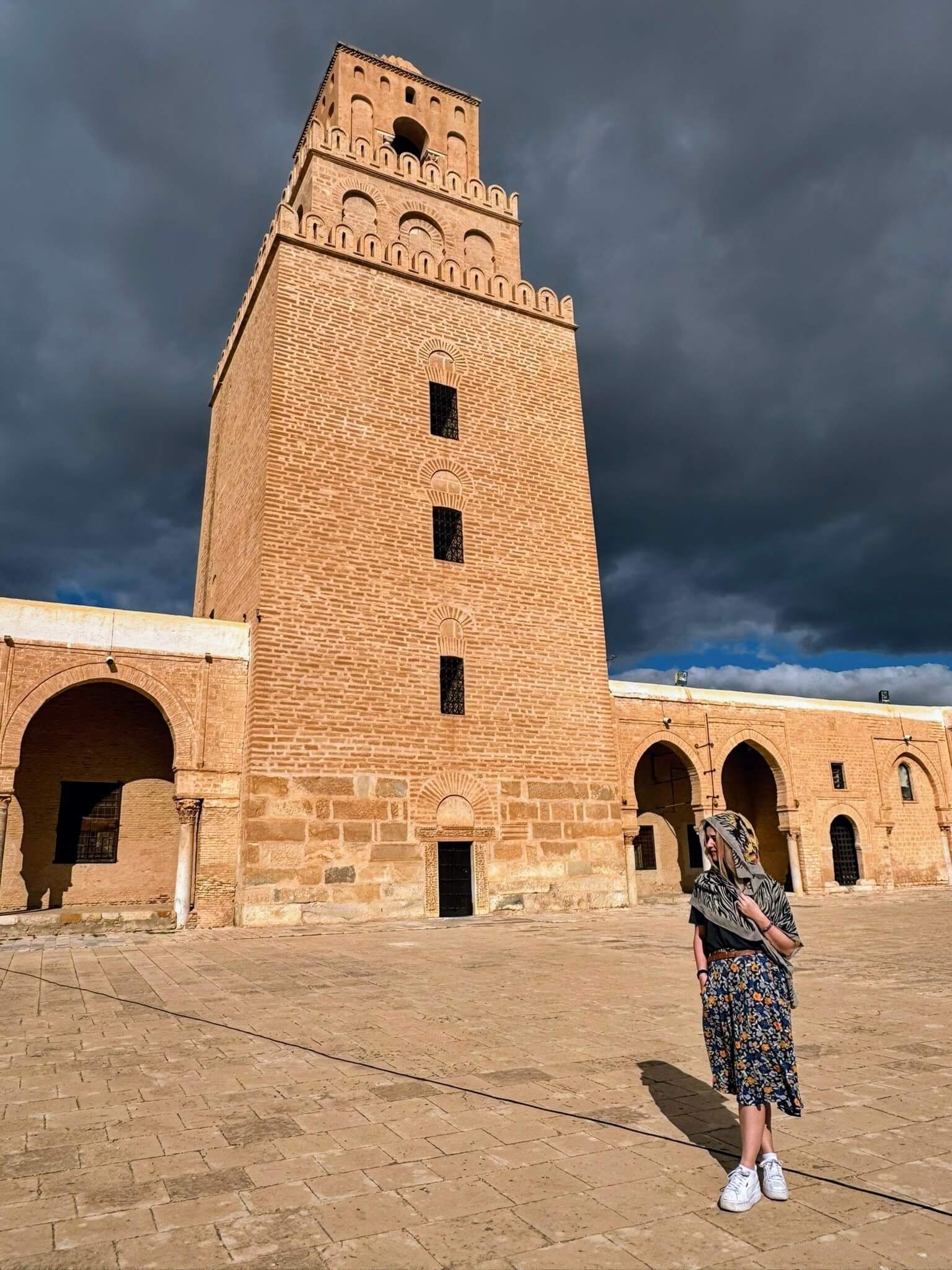
The Great Mosque of Kairouan, is a stunning example of early Islamic architecture and one of the oldest mosques in the Islamic world, dating all the way back to 670 AD.
With a massive courtyard flanked by elegant archways, intricately carved wooden doors, and a towering minaret, the Great Mosque of Kairouan is a sight to behold.
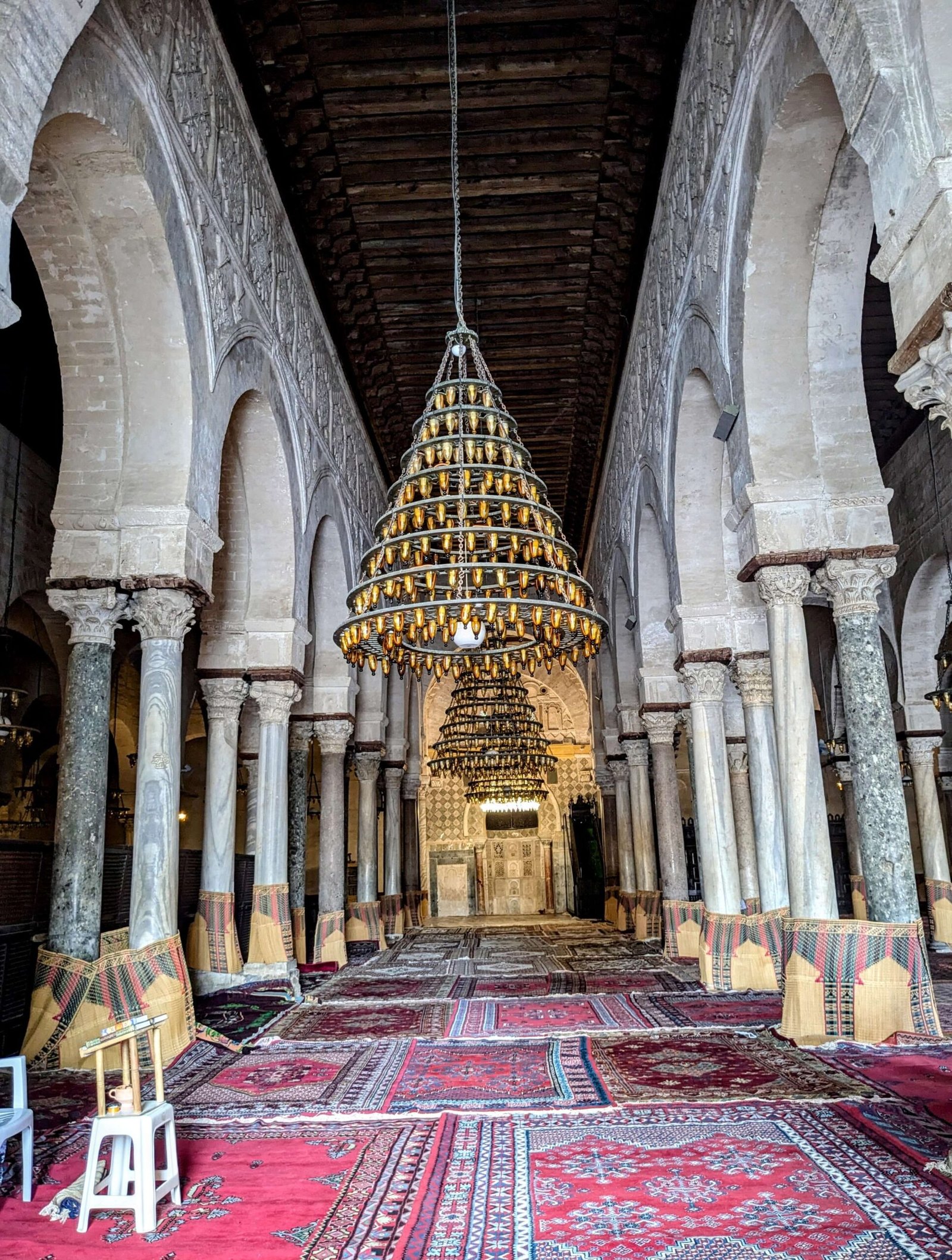
Need to know:
- The Grand Mosque costs 12 TND to visit (£3), but this ticket allows you to enter 5 additional sites in Kairouan (Sidi Abada Mausoleum, Rakkada Museum, Basins of Aghlabides, Sidi Abid Mausoleum, and Abi Zamaa Mausoleum).
- Non-Muslims are not allowed to enter the prayer hall, but are able to take a peek inside. The courtyard is open to everyone.
- Headscarves are provided free of charge for women.
After you’ve finished marvelling at the Great Mosque, it’s time for lunch!
We went to an absolutely gorgeous restaurant named Dar Abderrahman Zarrouk (Google Maps link), inside the Medina of Kairouan.
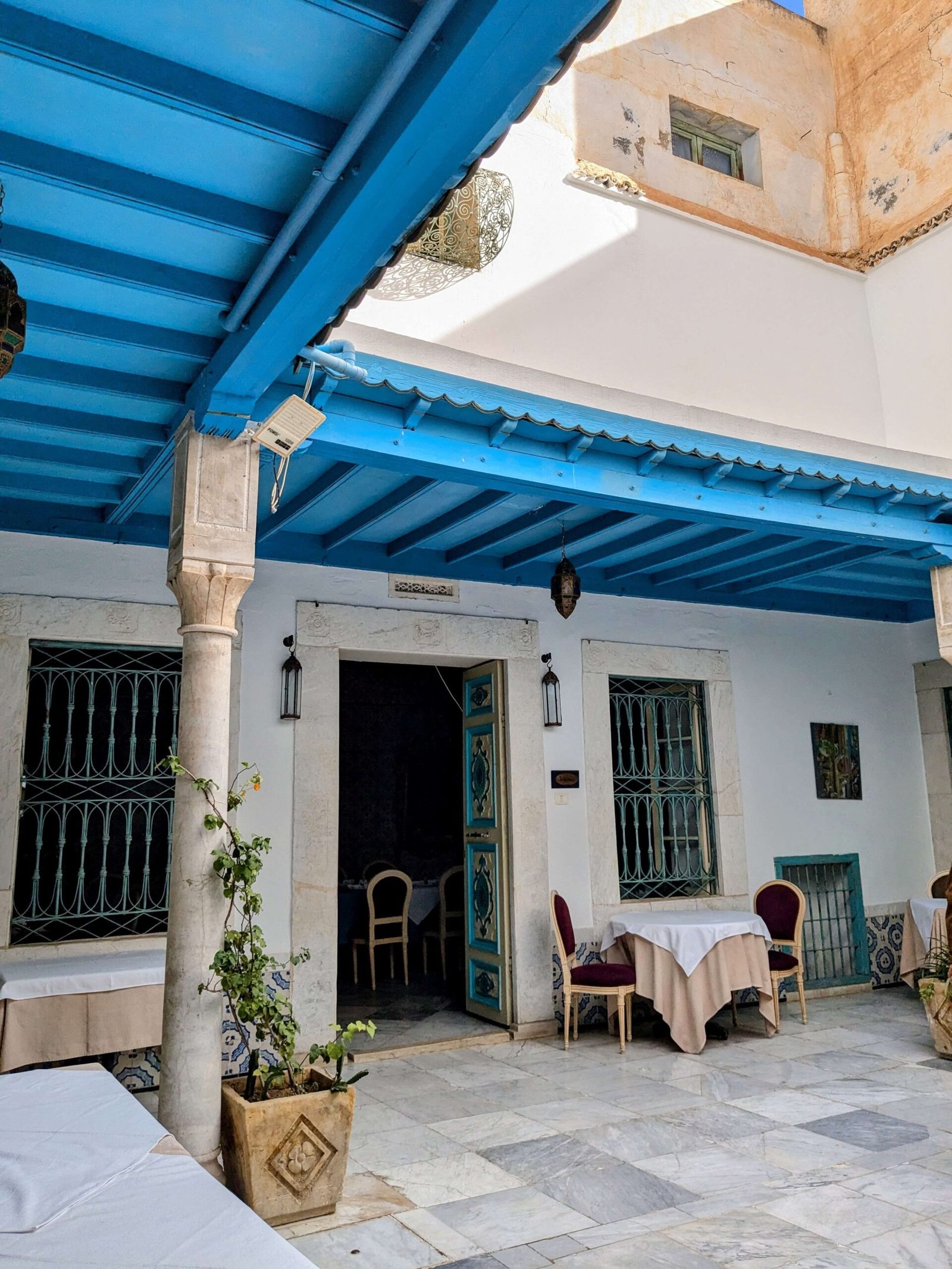
The 18th century building was once a home where multiple families would have lived, side by side.
The courtyard is surrounded by rooms decorated with beautiful tiles, and the whole place has such a serene and tranquil aura to it, I could have stayed there all day!
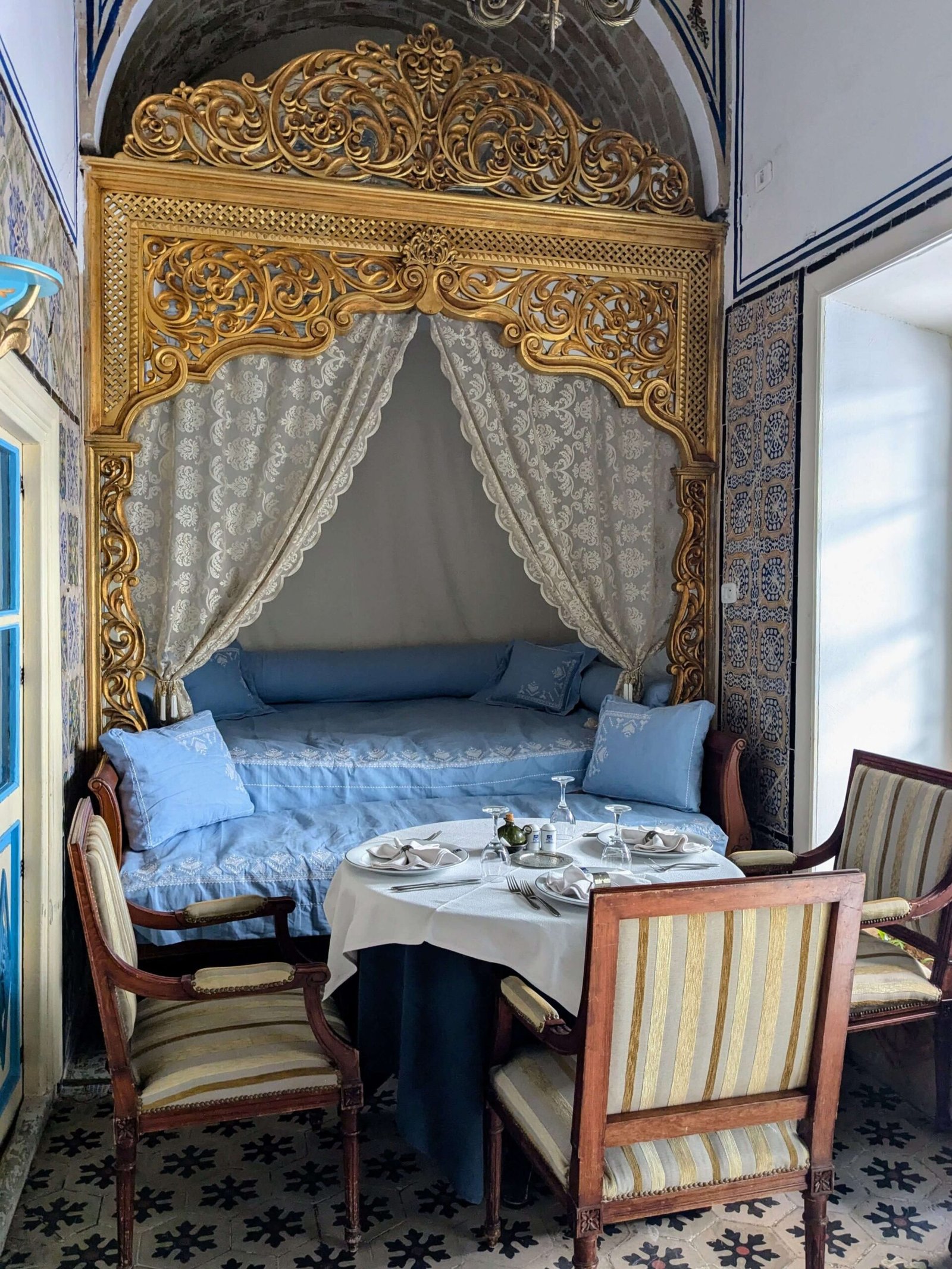
We opted for one of the set menus (about £12 per person), and enjoyed traditional Tunisian dishes such as lamb couscous, ‘Fingers of Fatima’ (which are like Tunisian spring rolls), vegetable soup, and a typical Tunisian egg and tuna salad.
It. Was. Amazing.
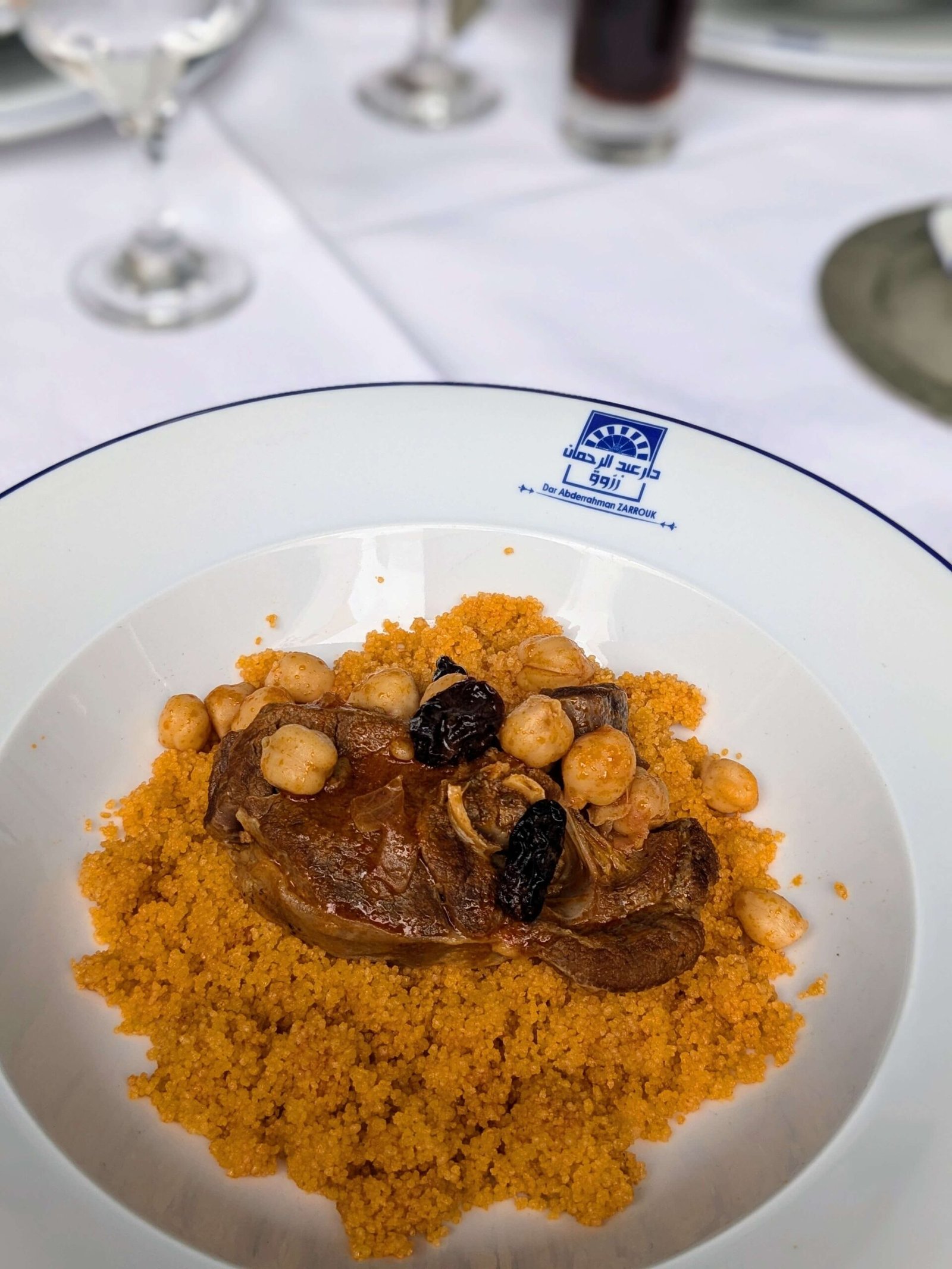
Afternoon/evening: Kairouan to Tozeur
You should aim to leave Kairouan by 2pm, because the drive from Kairouan to Tozeur could take up to 5 hours.
The drive itself is pleasant, with views of both desert and mountain, and you may even be lucky enough to enjoy the sunset!
When you arrive in Tozeur, check into your hotel and relax for the evening.
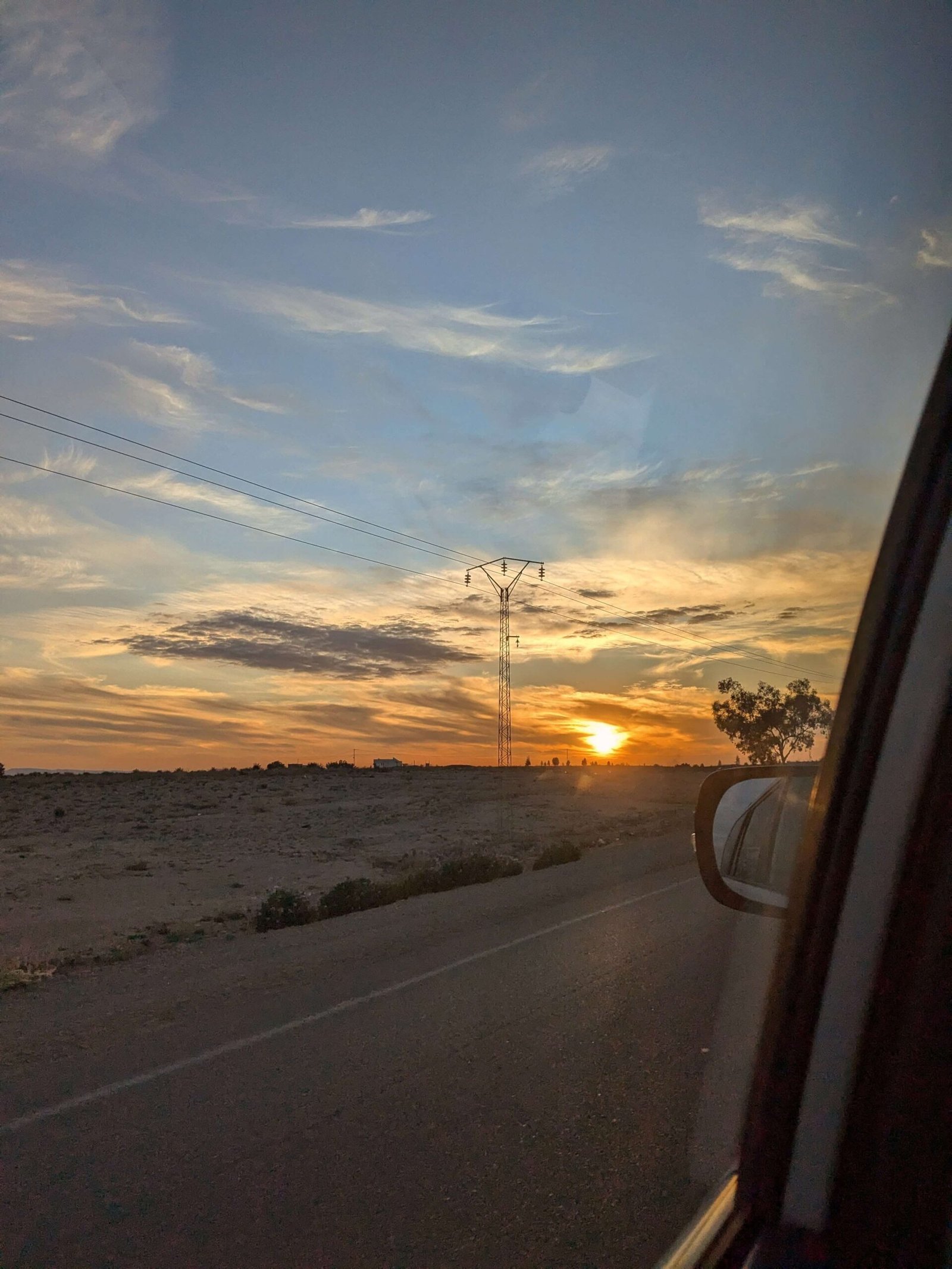
Where to stay in Tozeur
We stayed at the 4-Star Ksar Rouge El Dorador Hotel in Tozeur and I loved it.
I couldn’t find it on Booking or Expedia (guess they don’t wanna pay those commission fees, heheh), but I did find it listed on Agoda, which you can find here.
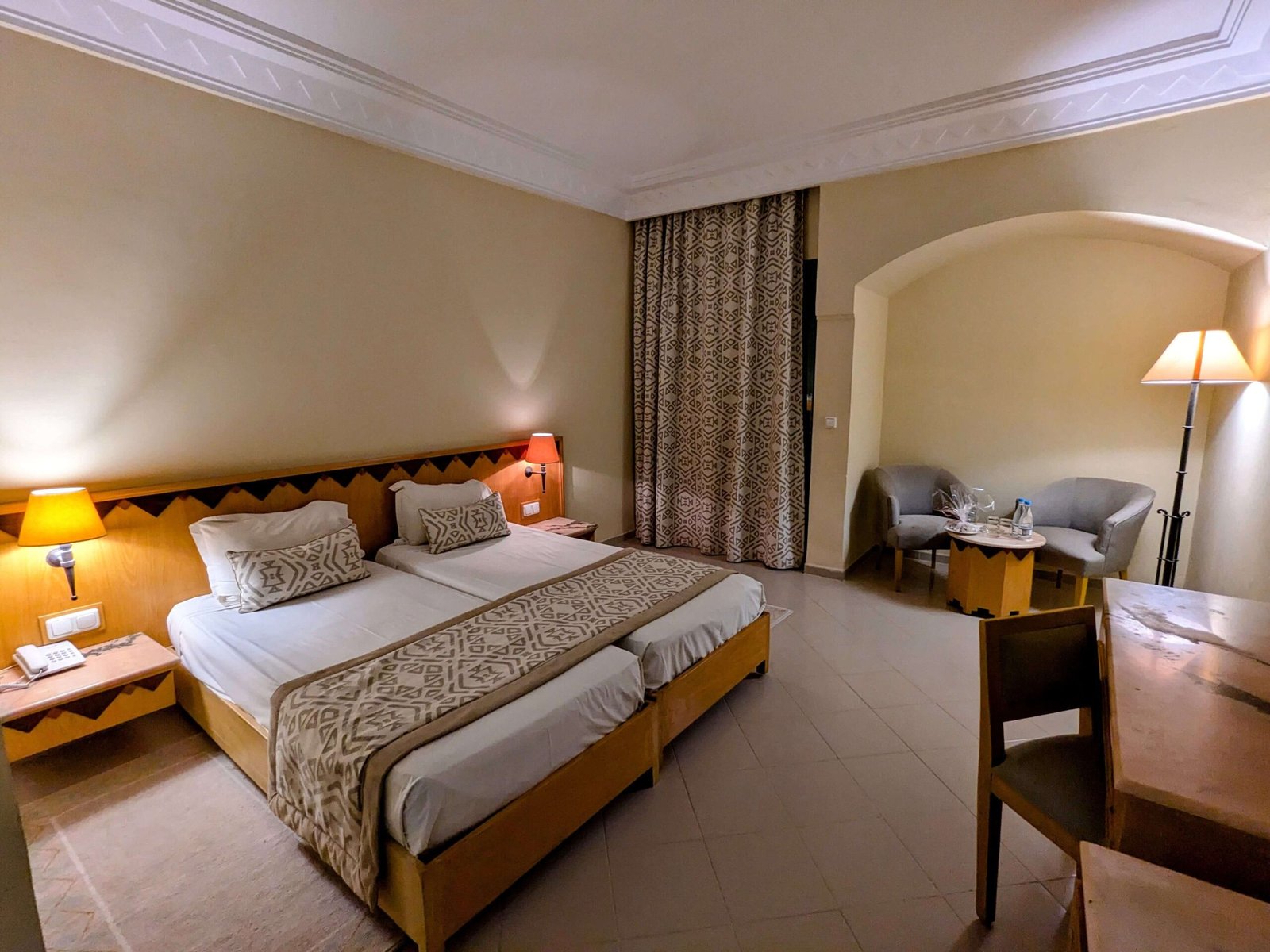
Not only did the Ksar Rouge have a luxurious pool and comfortable rooms, but it also had a great buffet restaurant and cosy bar area.
I really enjoyed my time here.
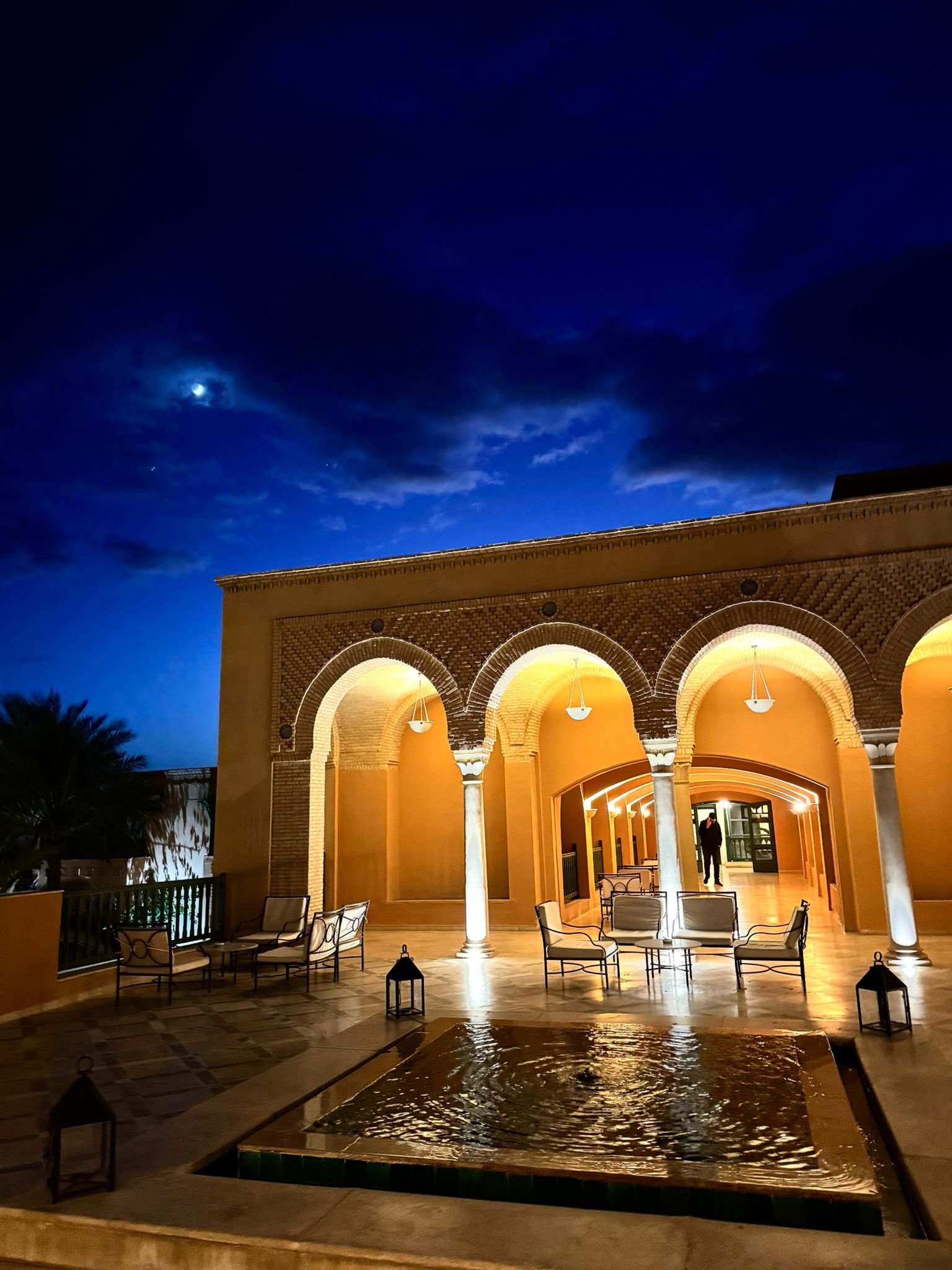
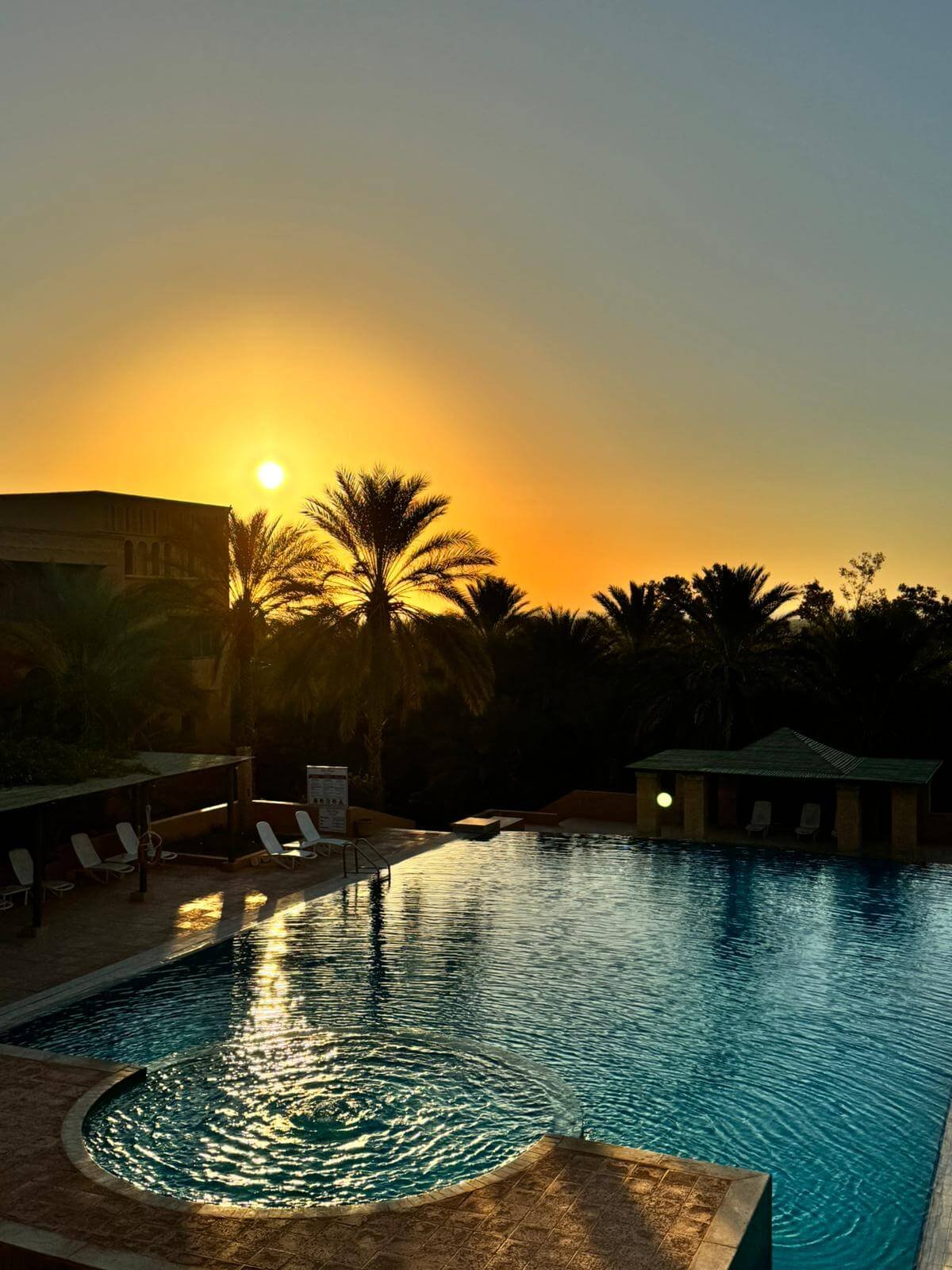
Another luxury hotel in Tozeur is the Palm Beach Palace Hotel, a few steps away from the Ksar Rouge.
I didn’t stay here, but I did have a drink in the hotel bar and attend a press conference here, so I managed to get a feel of the place (and it was an ‘I want to stay here!’ kinda feel).
Day 3: Tamerza, Midès, Chebika
It’s time to explore the desert oasis surrounding Tozeur.
Today, you’re going to visit some beautiful canyons and waterfalls, so make sure your camera is fully charged!
As I visited Tunisia as part of a press trip, our excursion was organised by the tourism board, but I did find this exact itinerary on a GetYourGuide tour, which is by far the easiest way to see everything I’m going to tell you about (unless you’re going to hire a car and drive yourself, of course).
Morning: Tamerza waterfall and canyon
About an hour away from the centre of Tozeur, you’ll find the Canyon Panorama viewpoint (Google Maps link), which offers sweeping views of dramatic cliffs, rugged gorges, and the vast expanse of desert beyond.
Standing at the edge of the canyon, it’s impossible not to feel dwarfed by the sheer scale of nature’s raw beauty.
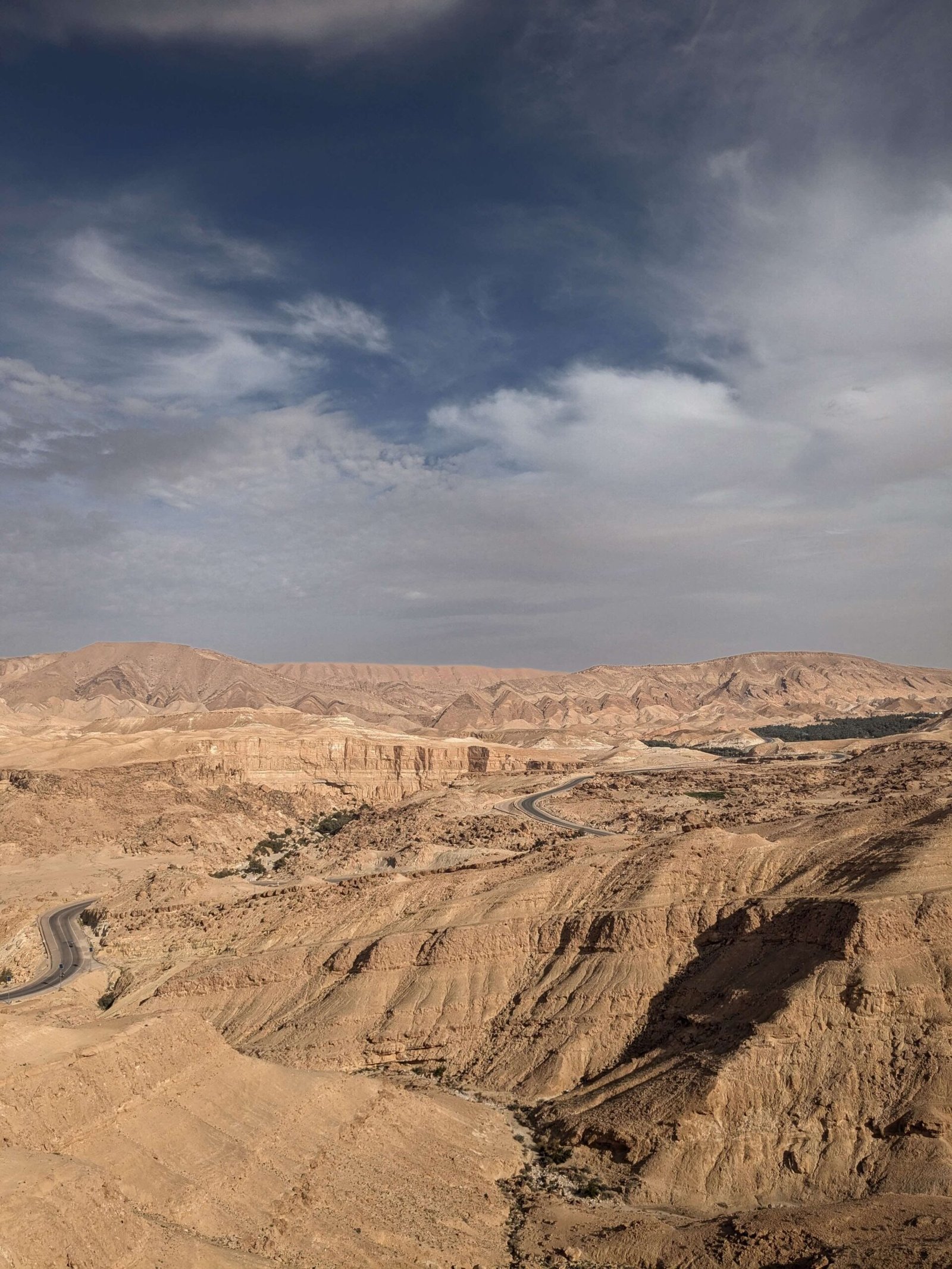
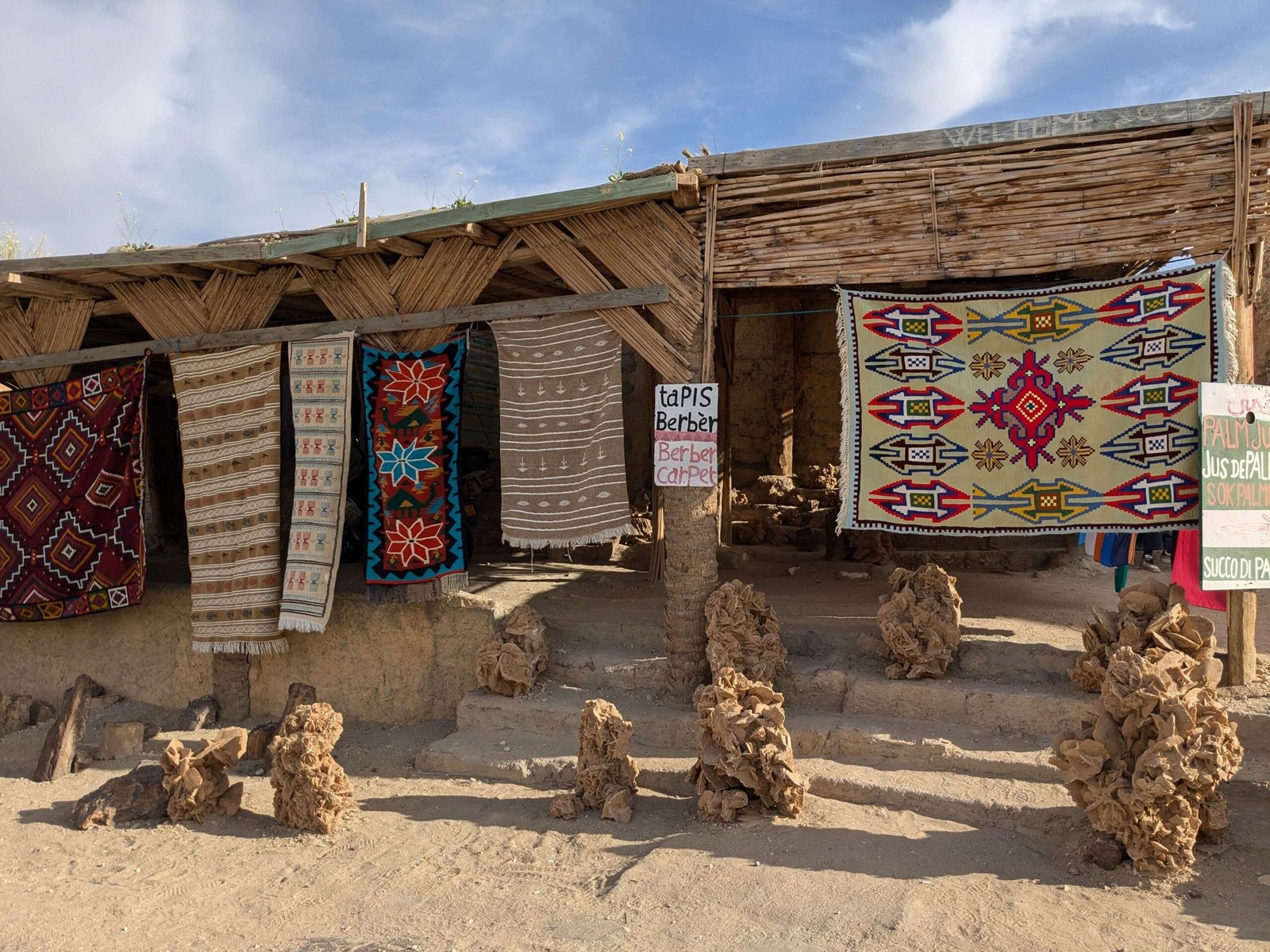
Here, you’ll find a roadside shop selling some traditional Berber carpets and other handmade souvenirs. It’s a nice place to stop, grab a cold drink, and take a look around.
Tamerza (Tamagza in Arabic) waterfall is a small cascade nearby. From here, you can take a short walk to the gorge of Tamerza canyon, where you’ll find fossils embedded into the rockface.
The best way to reach both of these spots is by passing by Restaurant Cascade (Google Maps link), on the outskirts of the village of Tamerza.
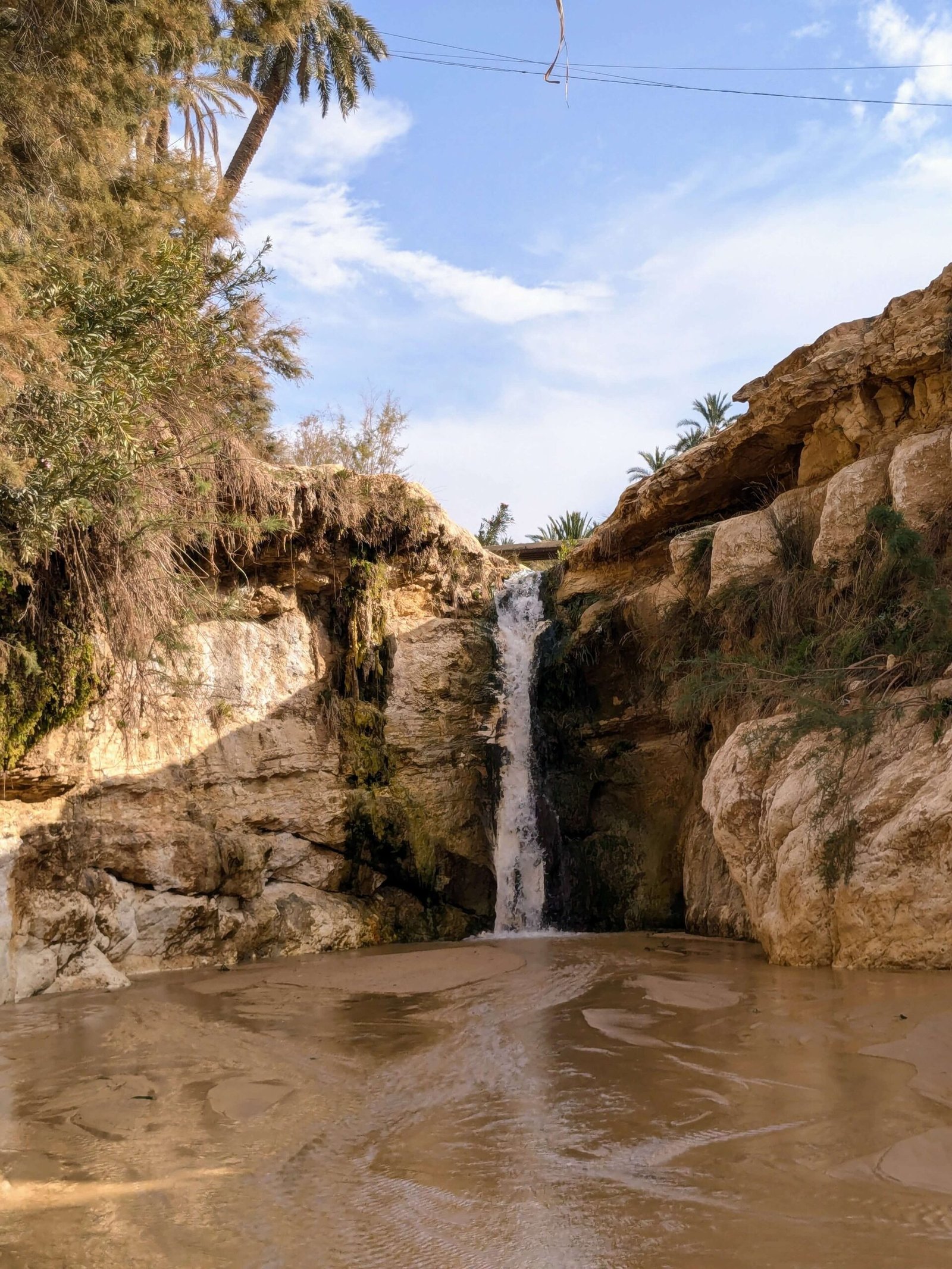
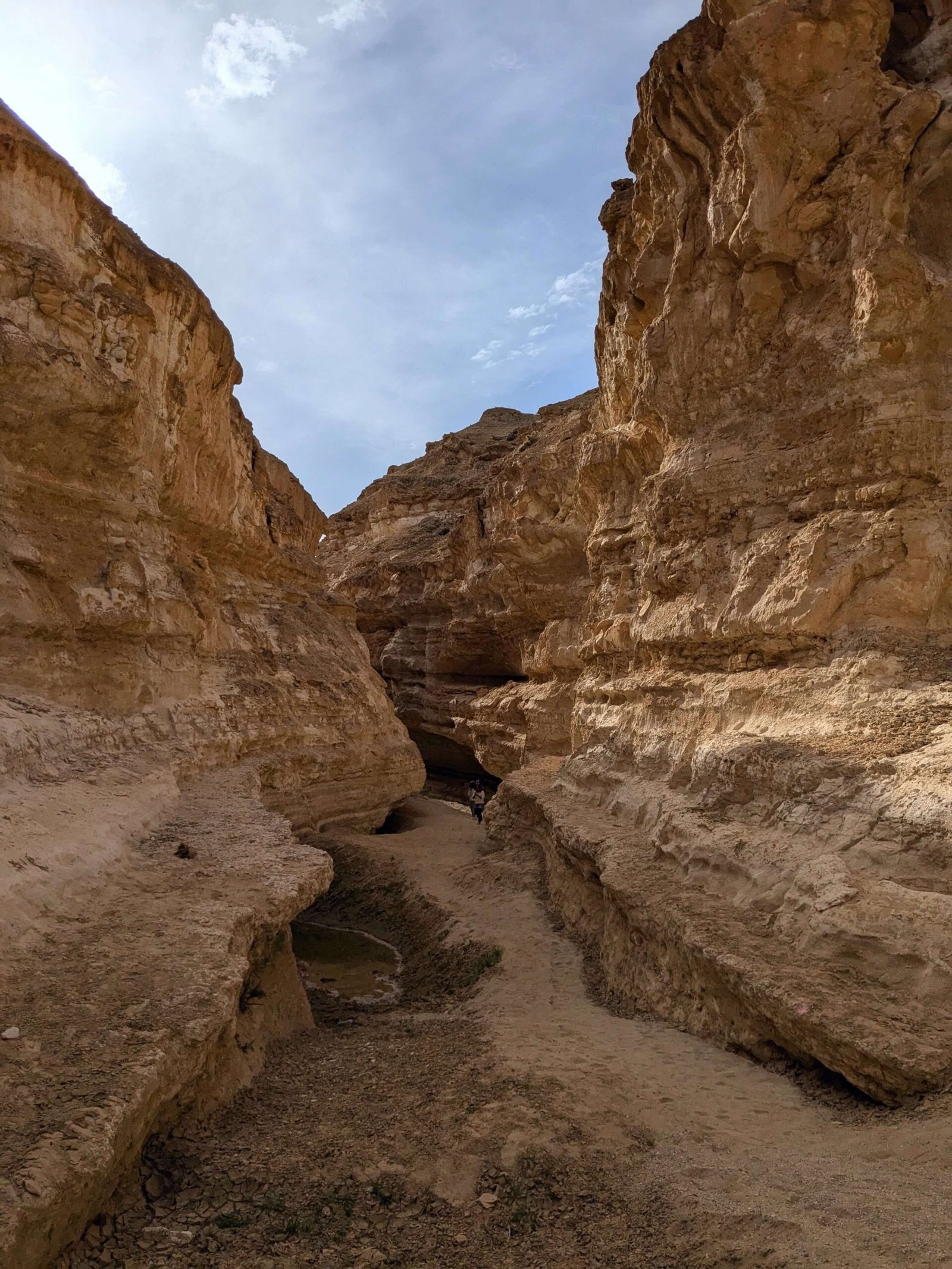
Afternoon: Midès, Chebika
Next, you’ll head to Midès, where you’ll have the opportunity to meet some local woman and learn how they make the traditional Tunisian wool carpets. They will serve you coffee, mint tea, and local snacks and tell stories about the unique symbols weaved into the carpets.
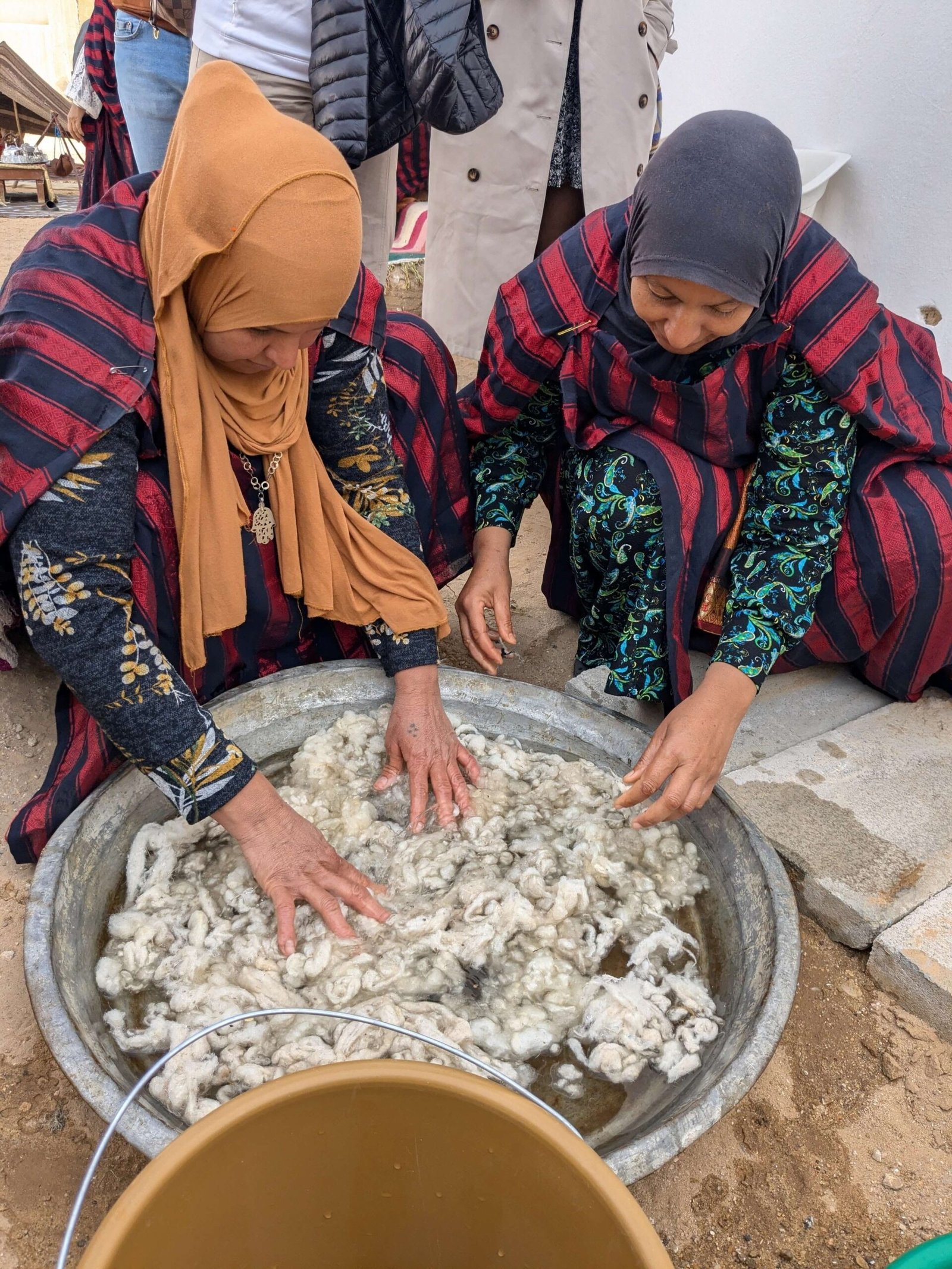
This association, called Merdessiyet, is aimed at empowering rural women, and while it doesn’t have a website yet, you can contact them via Facebook to enquire about this experience! The cost is about 30 TND (£7.50) per person, depending on group size.
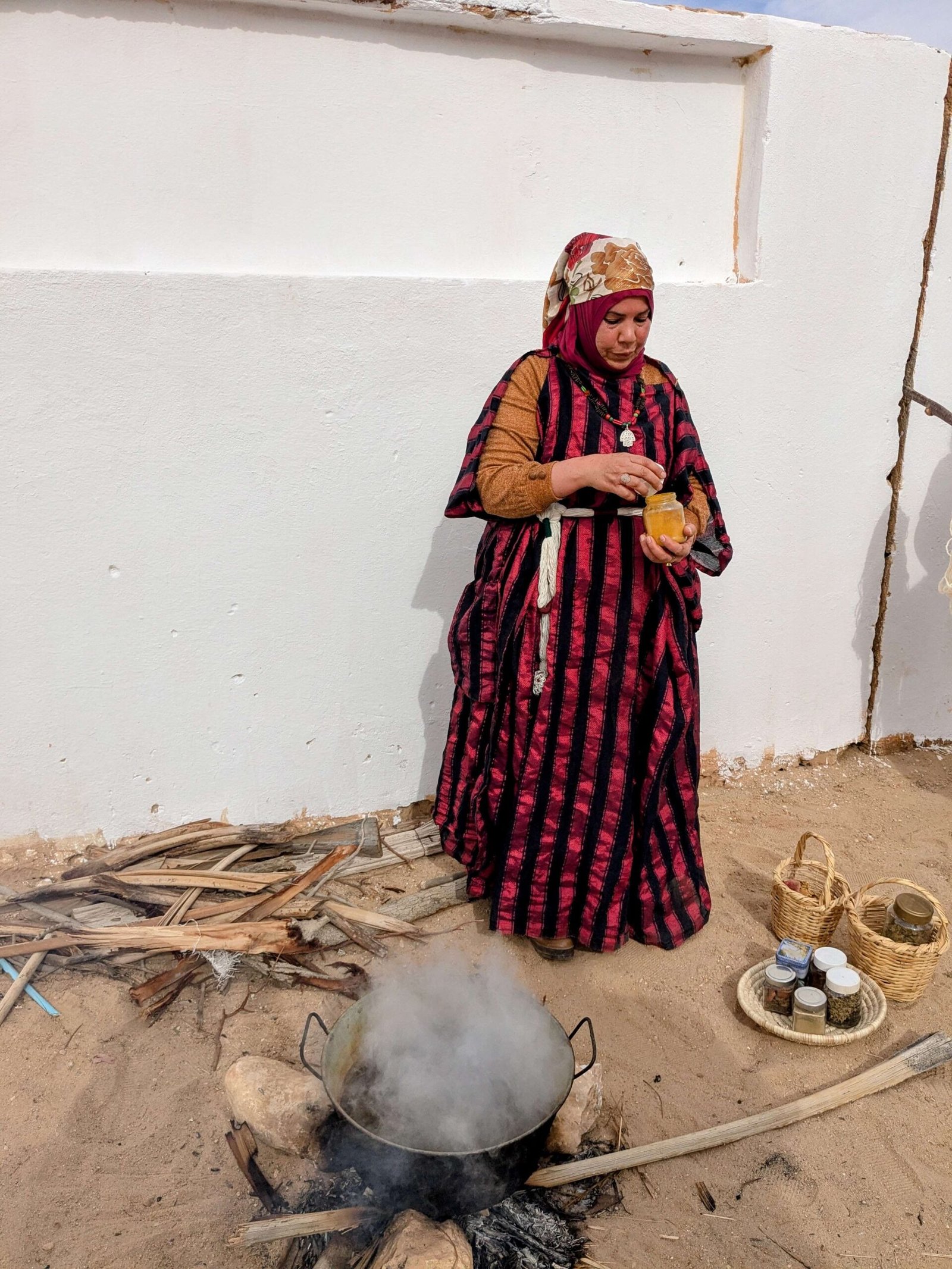
Also in Midès is a great viewpoint that you shouldn’t miss.
Walk through an ancient abandoned village (Google maps link), and continue on to the stunning canyon (Google maps link), which you might recognise as one of the filming locations for The English Patient.
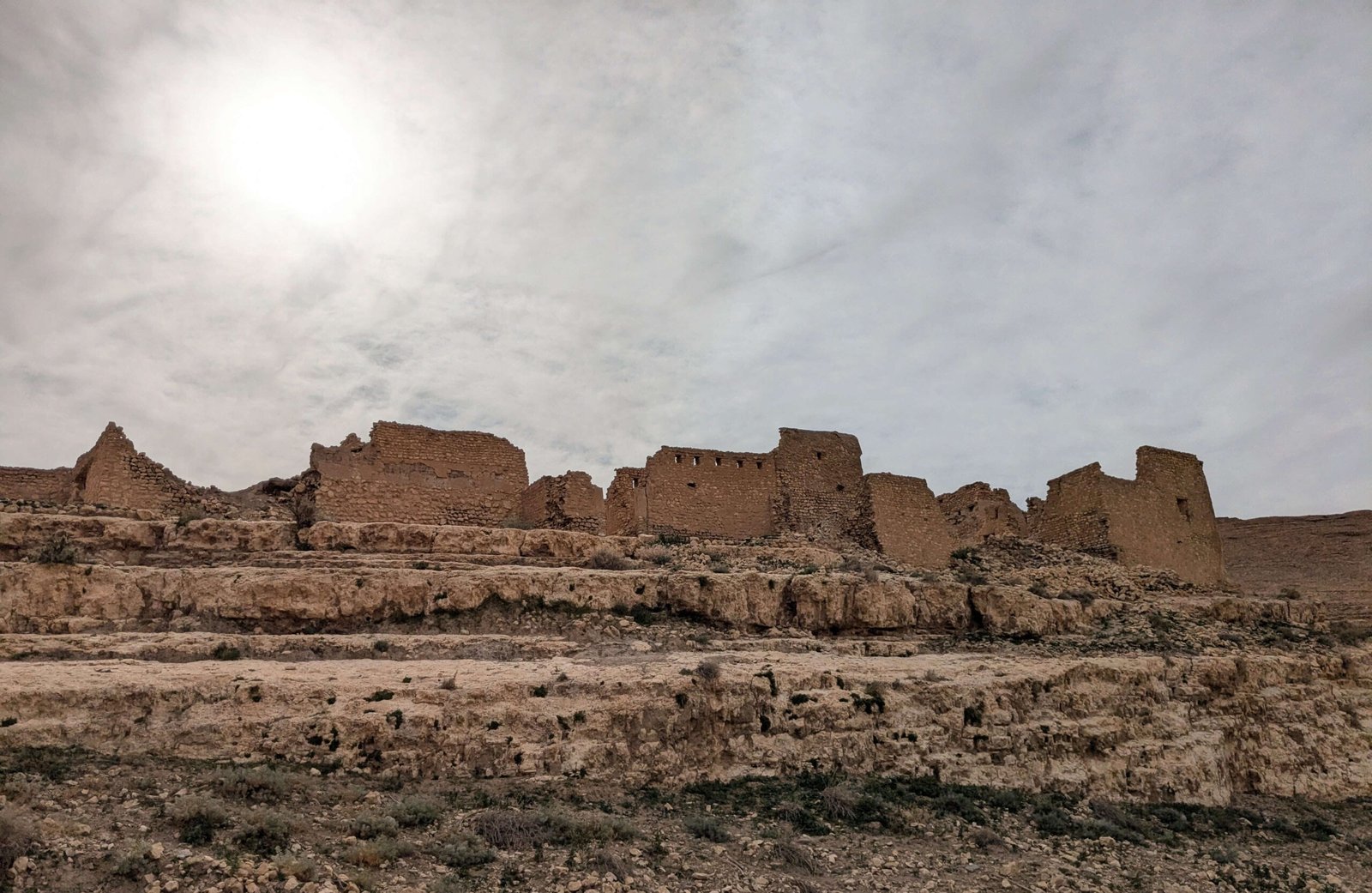
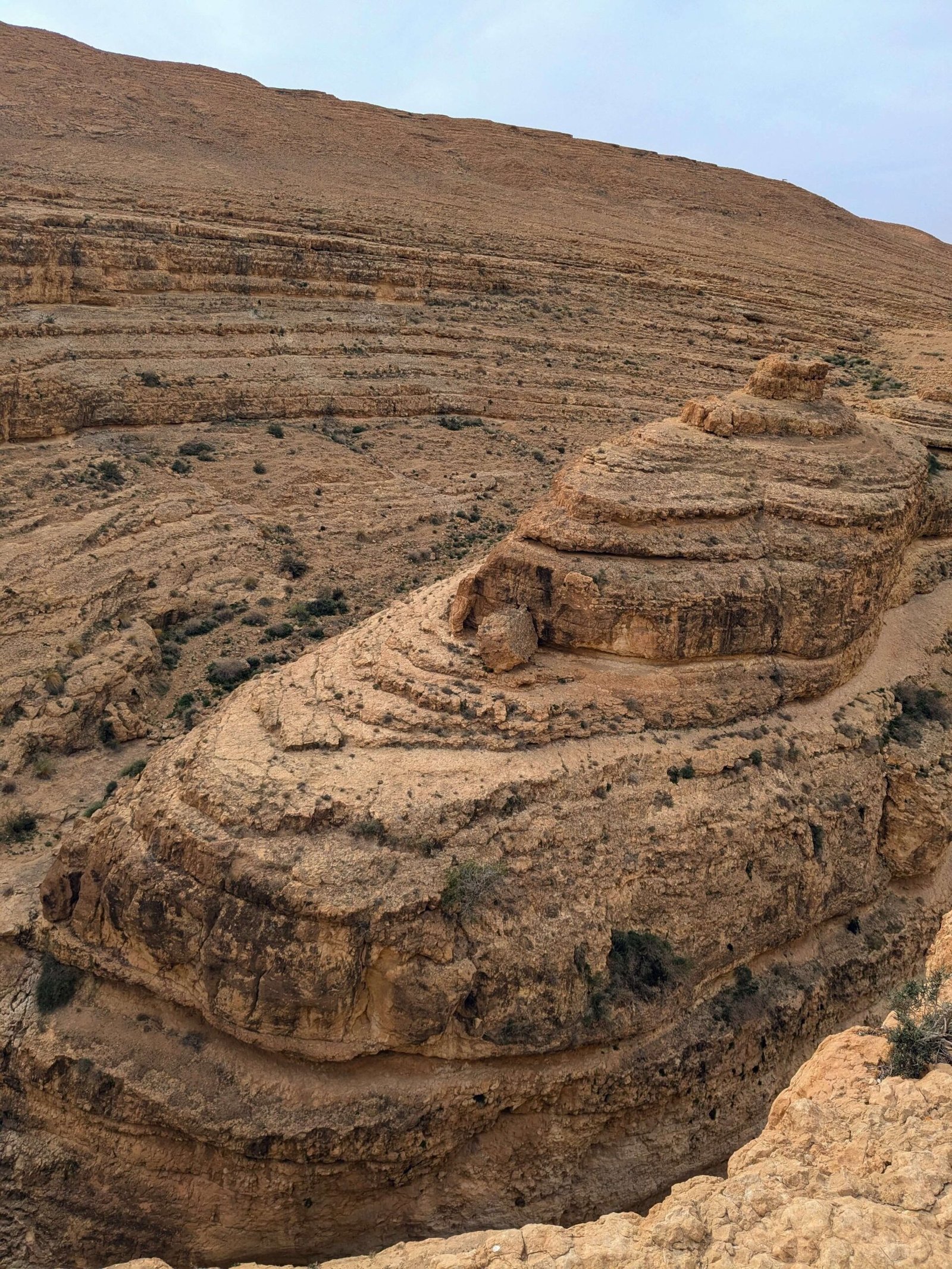
After drinking in your surroundings, head to Midès Family Resto (Google Maps link) for lunch. This no-frills family eatery serves simple yet hearty Tunisian food, and it may be basic, but it’s also delicious.
I enjoyed tuna salad, lentil soup, and couscous with chicken and vegetables, washed down with a piping hot Turkish coffee.
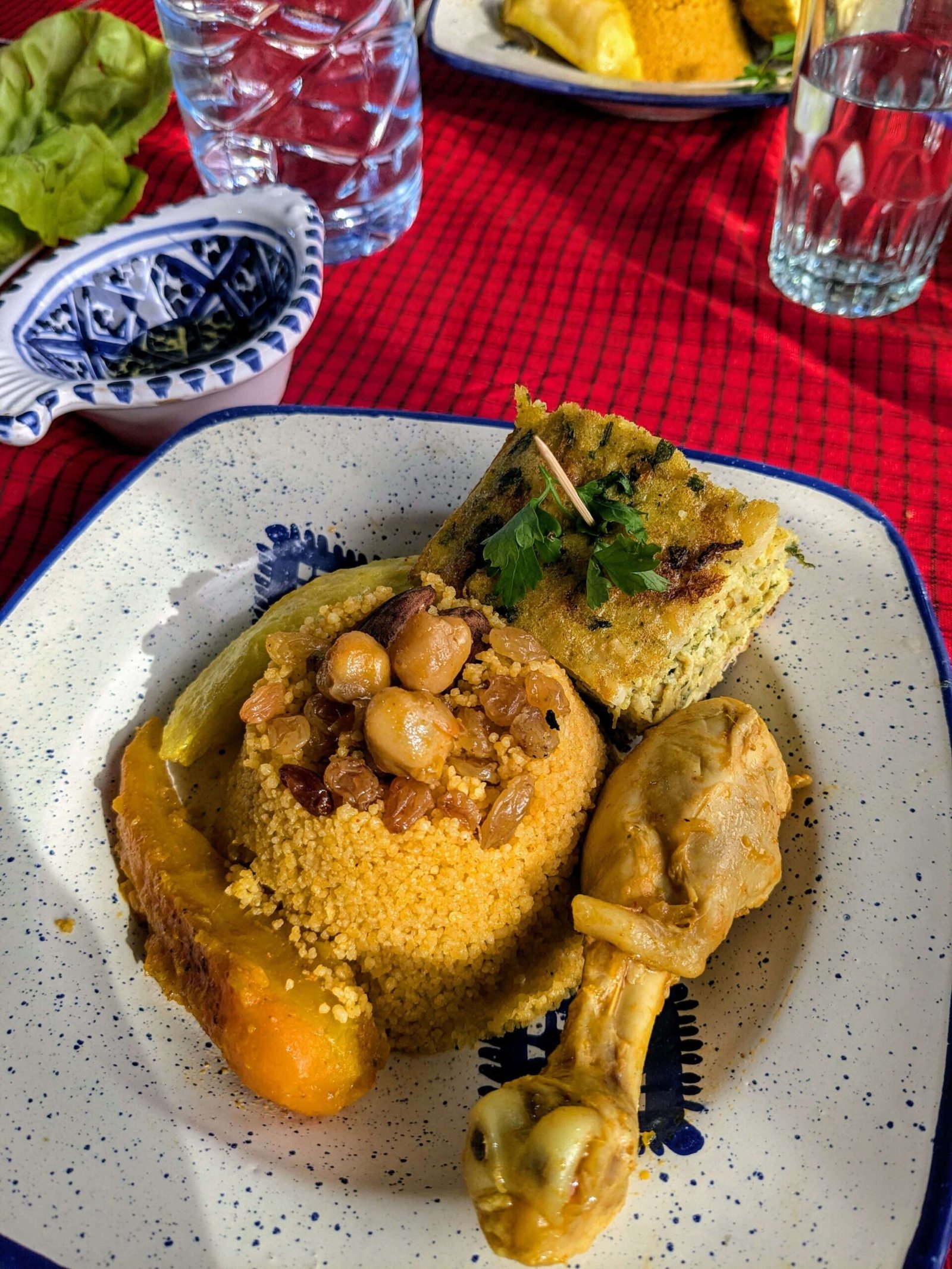
Finally, you’ll head to the historic village of Chebika (Google maps link). Wander round and take a look at the local handicrafts before taking the short walk to Chebika Oasis (Google maps link).
The narrow trail is lined with date palms and trickling streams, as well as parts where you can paddle or swim.
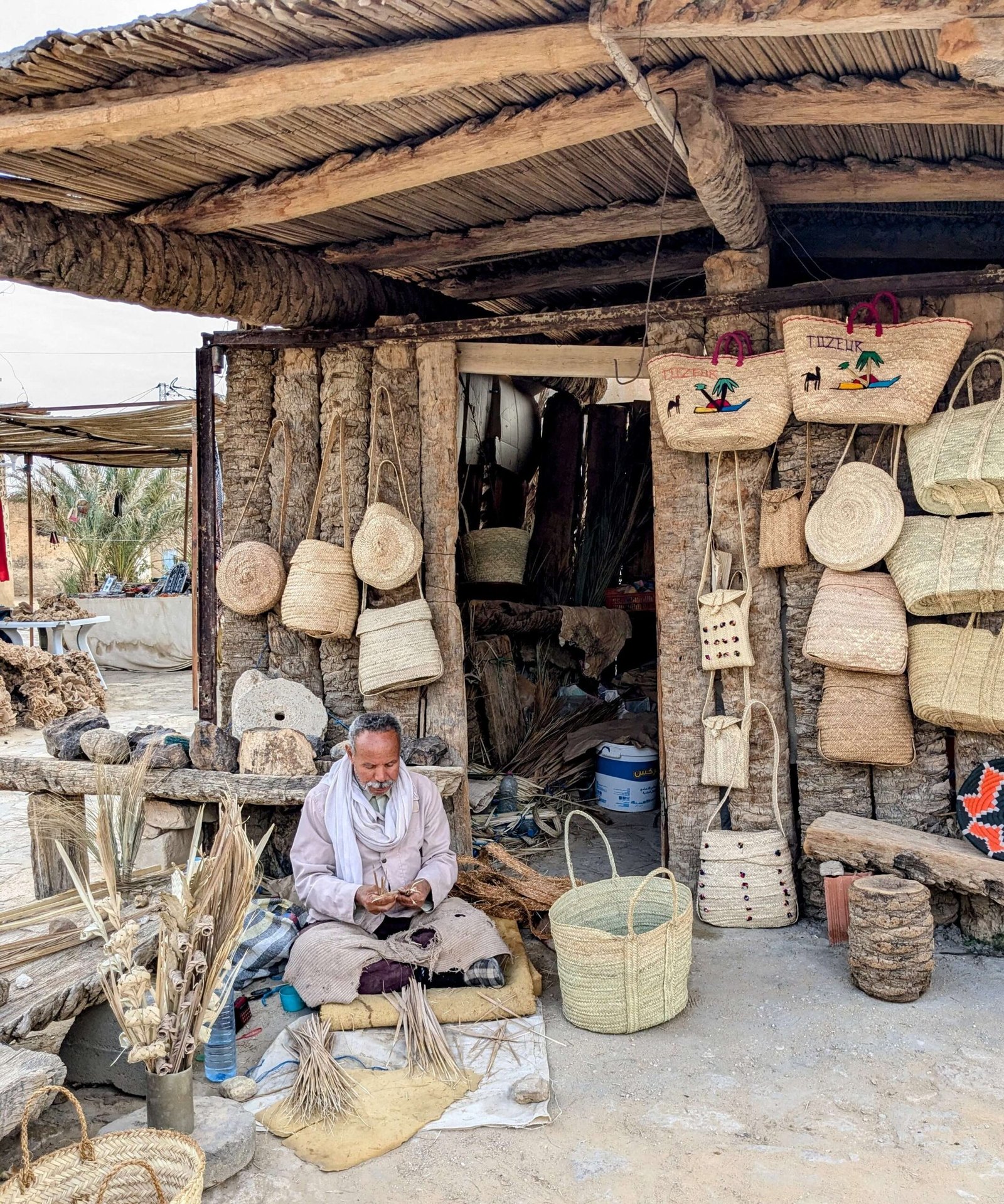
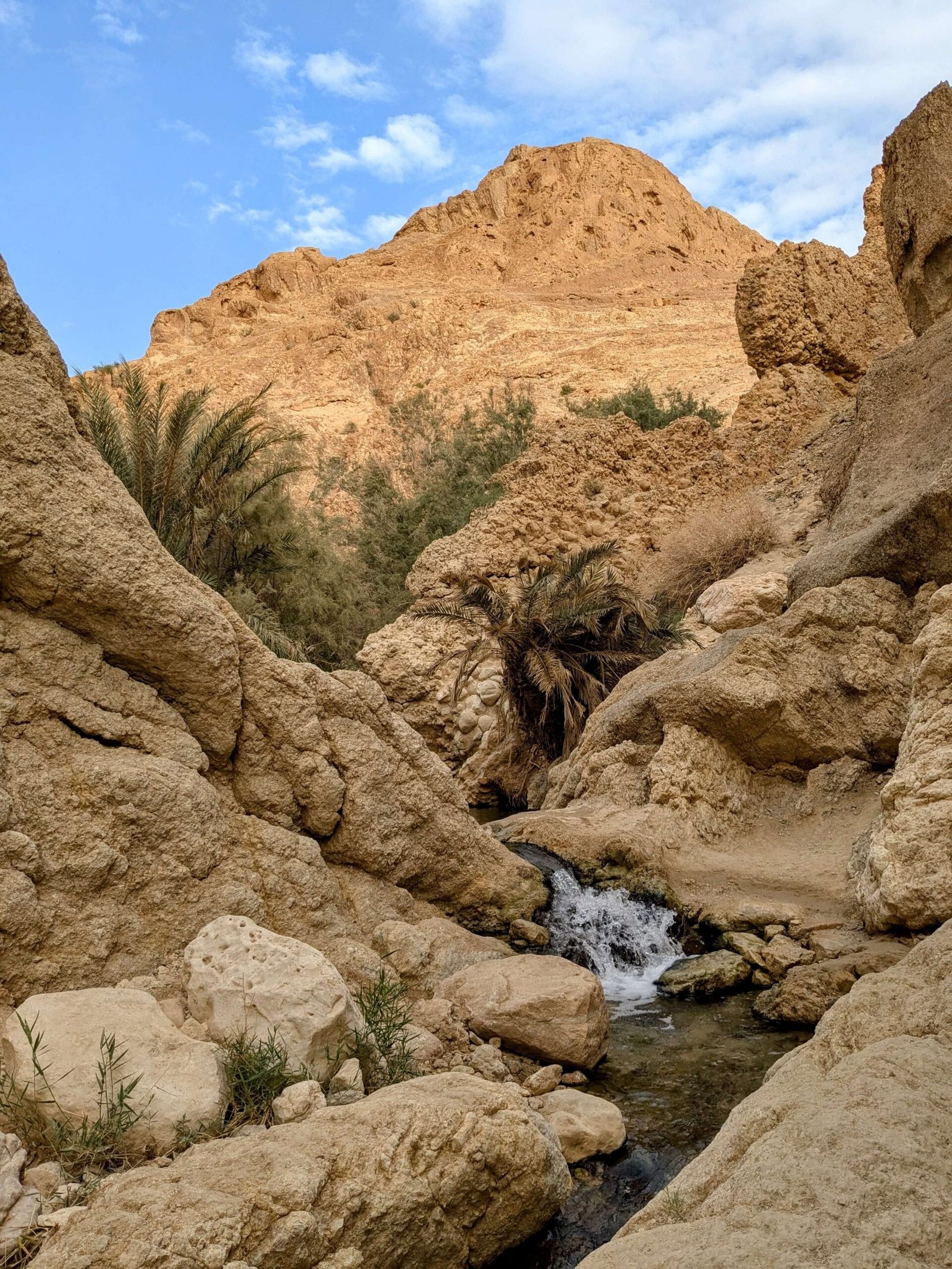
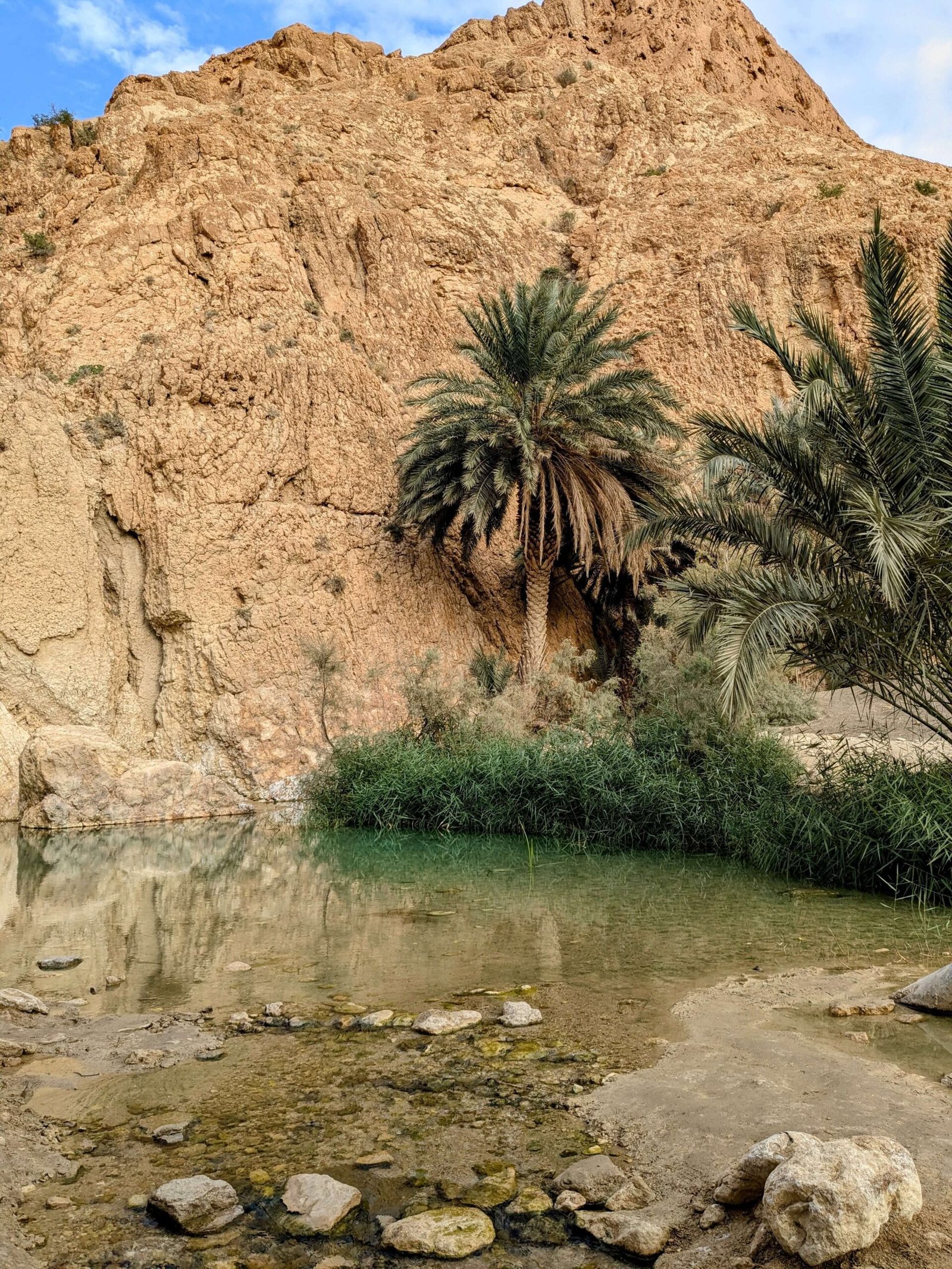
Along the way you’ll find teenagers selling amethyst and other semiprecious stones, desert roses, Berber jewellery, and fresh orange juice. If you’re interested, it’s worth stopping to buy something here.
Evening: Relax at the hotel
You’ll probably be tired after a long day, so I recommend eating dinner at your hotel.
Most of the luxury hotels have a buffet restaurant serving both local and international cuisine, along with live cooking stations.
Fill your belly and then unwind with a glass of Tunisian wine or lager (ask for Celtia) at the hotel bar.
Day 4: Tozeur, Mos Espa
Morning: The covered market Tozeur, Eden Palm
Start the day with a wander through Tozeur’s indoor market, which is a great way to experience local culture.
You’ll find beautifully woven Berber rugs, hand-painted pottery, and intricate palm leaf baskets. If you’re a foodie, the market is the perfect place to stock up on locally grown dates, particularly the famous Deglet Nour variety, as well as traditional sweets like makroudh.
You can also find small bottles of date syrup, olive oil, and spice blends to take home (I came home with enough makroudh, date jam, and olive oil to set up my own shop!).
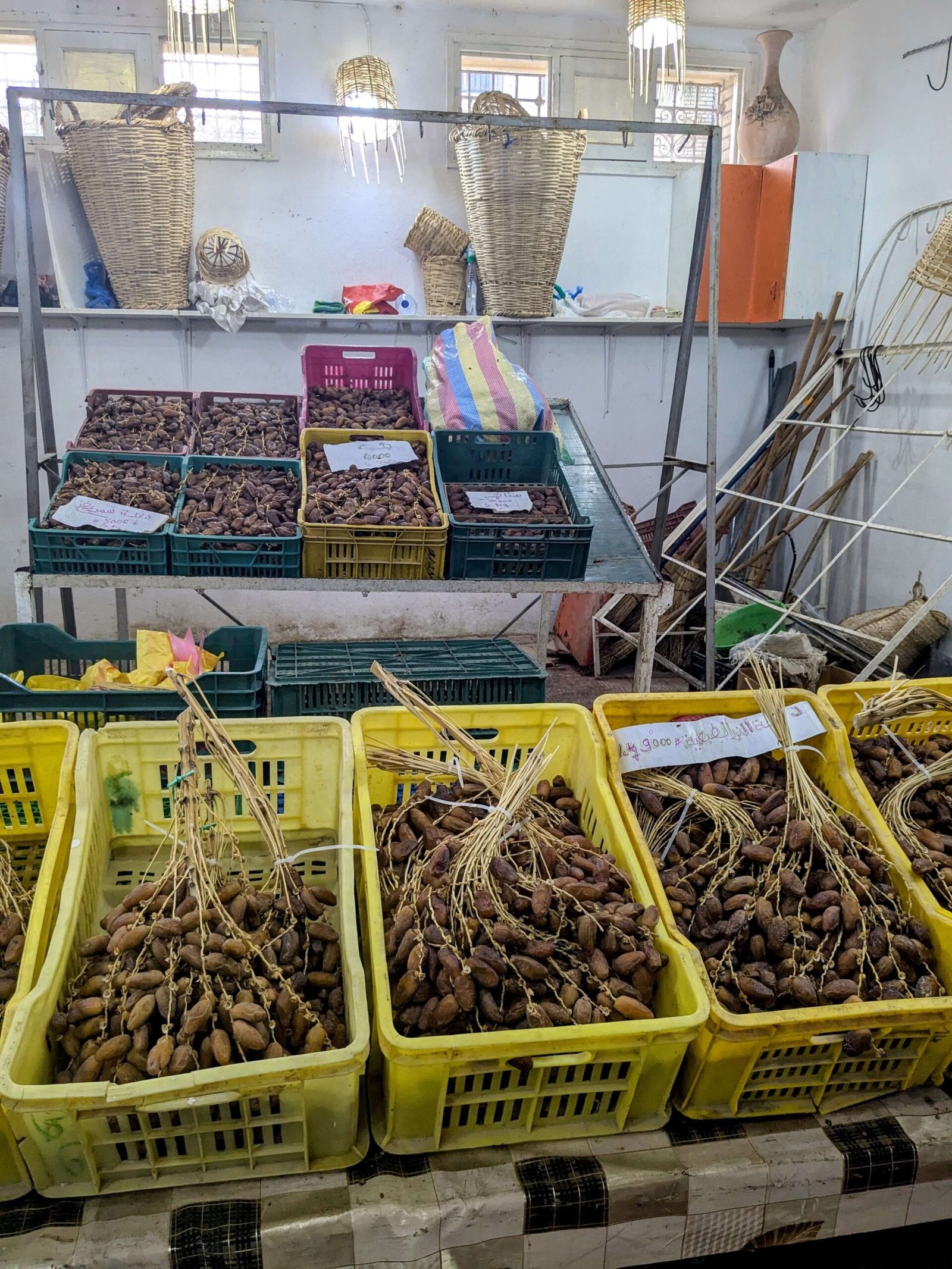
Next on your list should be a visit to Eden Palm, Tozeur’s very own date museum.
A museum dedicated to dates (of the edible kind) may not sound very interesting, but please believe me when I say that this museum was one of the unlikely highlights of my visit to Tunisia!
I mean, did you know that there are over 250 date varieties in Tunisia alone?!
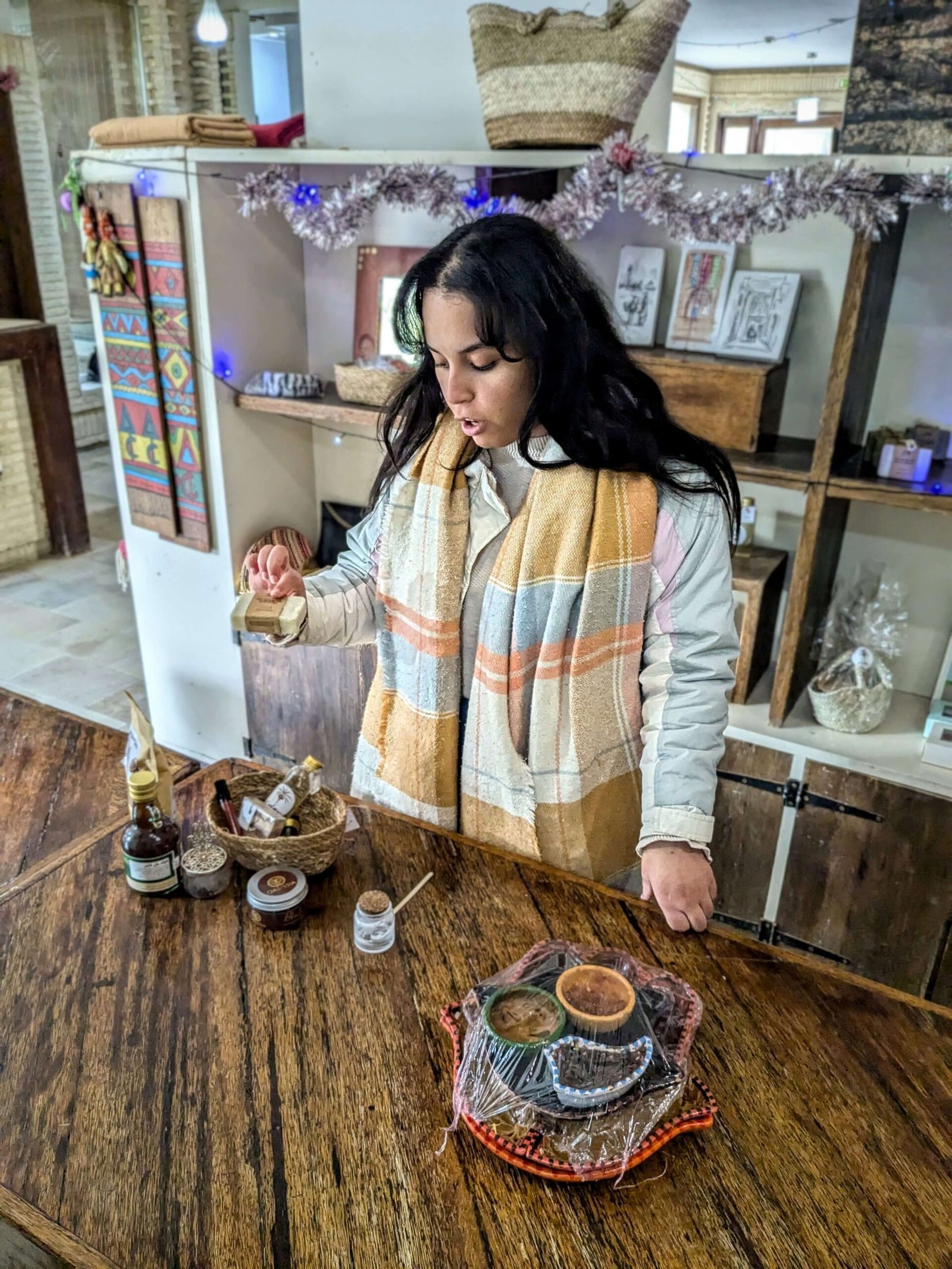
For 6 TND (£1.50), you’ll get a guided tour of the museum and palm forest, followed by a tasting of several different date jams and syrups. You’ll learn so much about dates and palm trees, and even if you were never interested in them before, you’ll walk away a fan, trust me.
Before you leave, don’t forget to take a look in the gift shop, where pretty much everything for sale is made from palm products (lip balms, moisturisers, shampoos, purses, notebooks; the list goes on).
There’s also a café where you can try date coffee and a range of delectable sweet treats made from – you’ve guessed it – dates.
Outside, there will be several horse and carriages, which will take you on a ride through the oasis for a small charge.
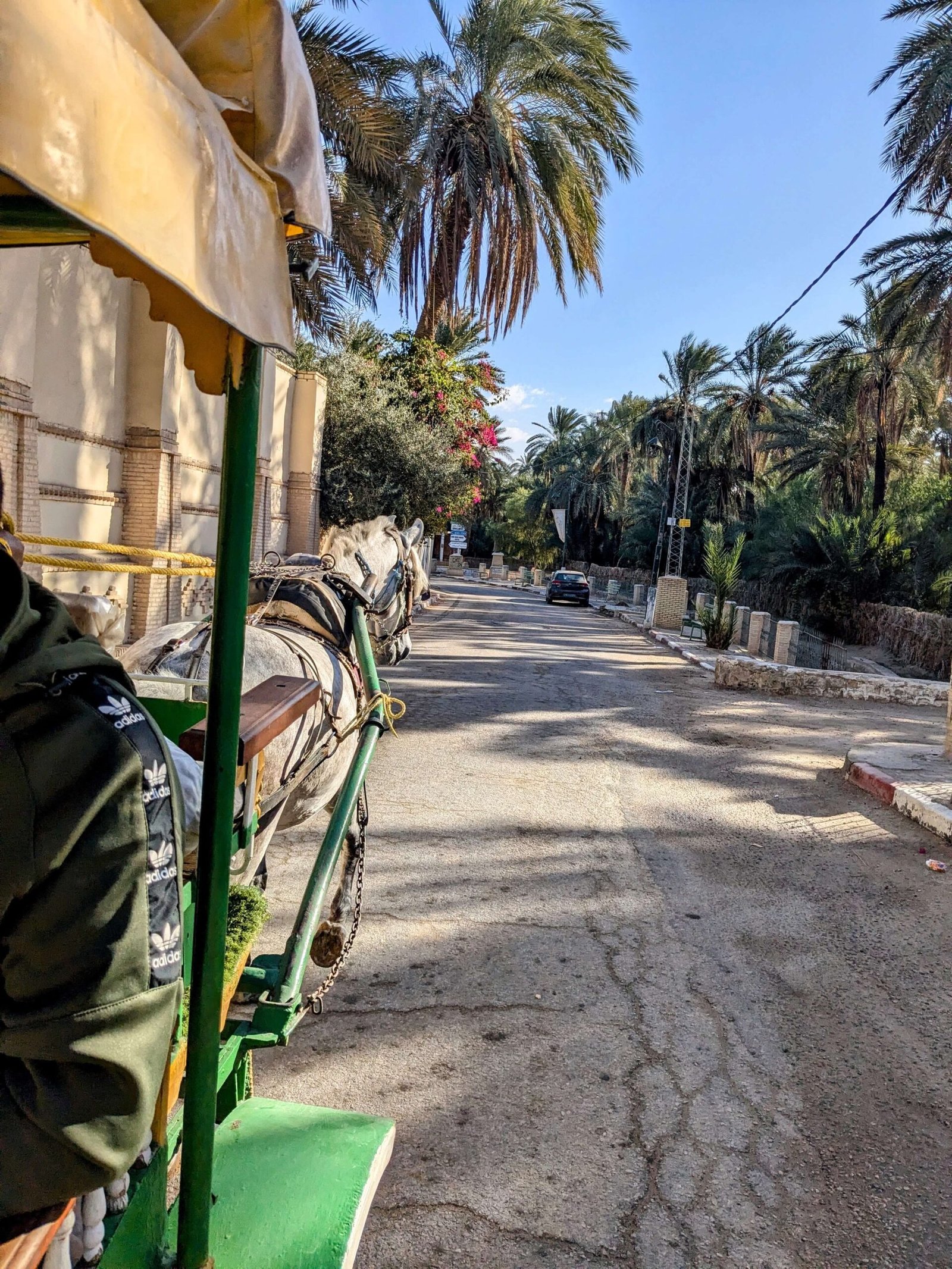
Afternoon: Mos Espa
Did you know that Tunisia is where a lot of the Star Wars filming locations can be found?
One of the most unique things to do in Tozeur (well, near Tozeur), is to visit some!
Book a guided tour (you won’t be able to navigate the Sahara desert on your own, no matter how confident of a driver you are), and head to Mos Espa.
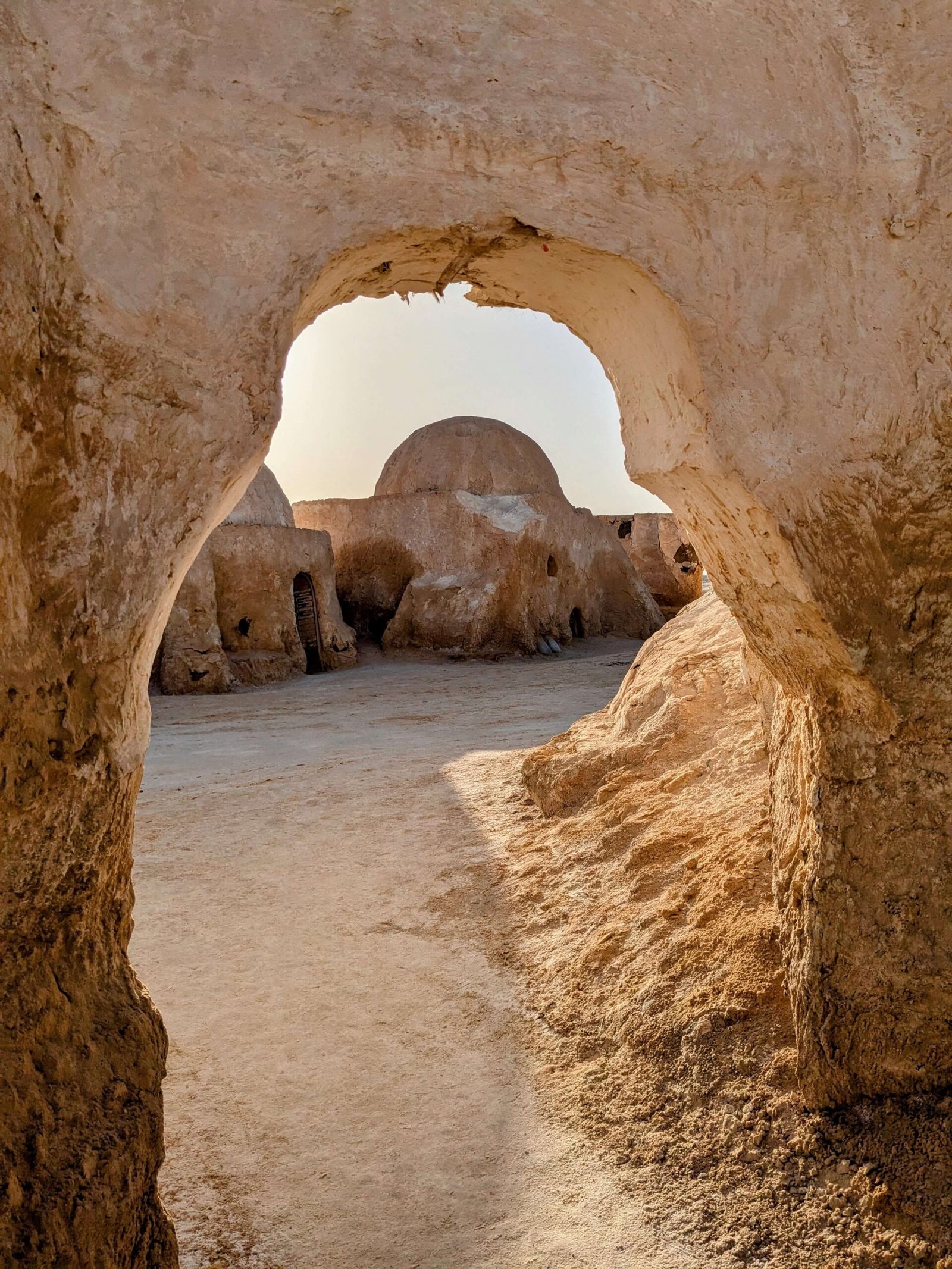
Even if you’re not a Star Wars fan (neither am I), Mos Espa is well worth a visit.
This abandoned film set in the middle of the desert is a surreal place to visit. You can explore and wander into the various huts freely, and although nature has begun to take its toll, it’s still a very special place.
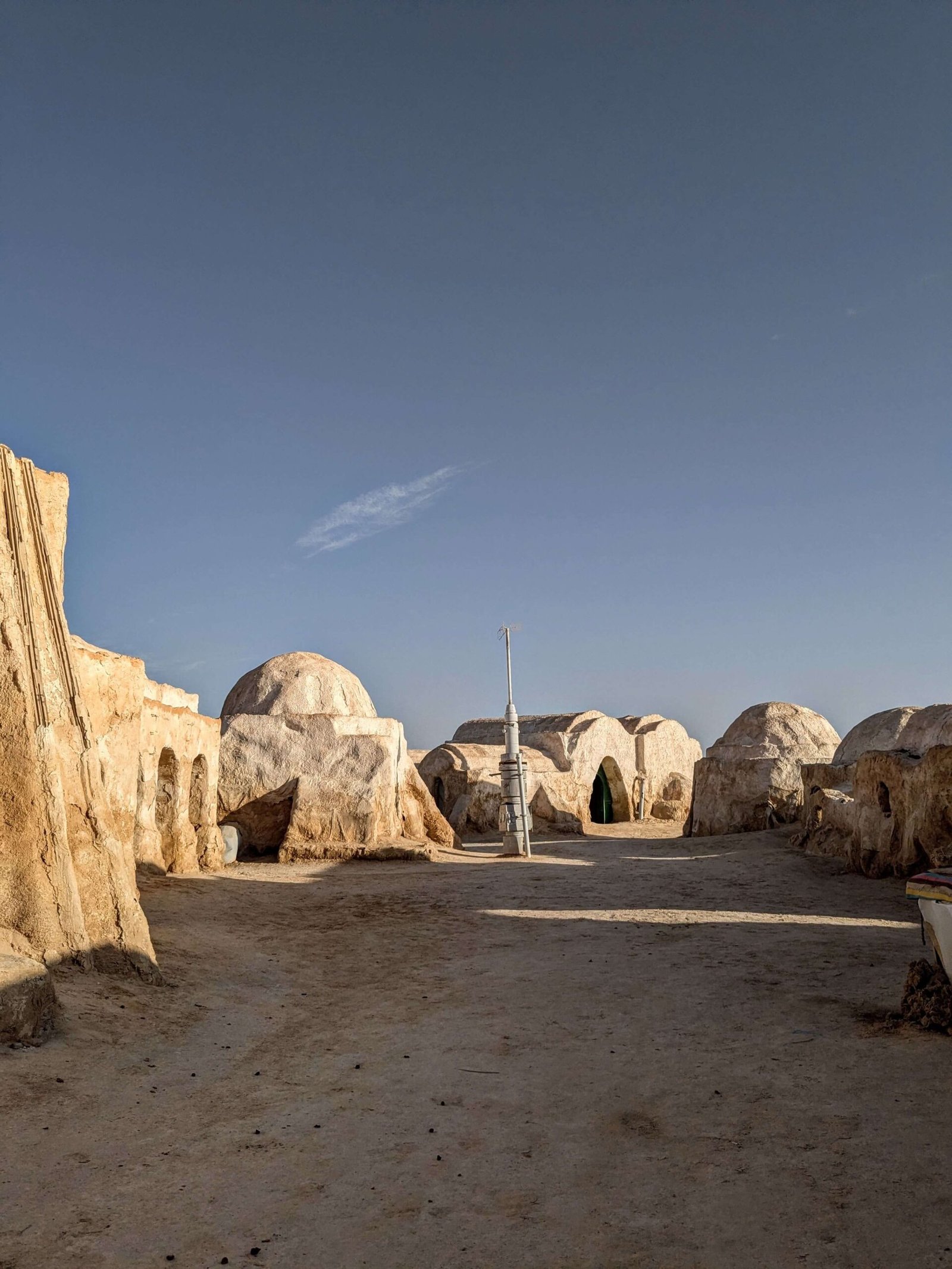
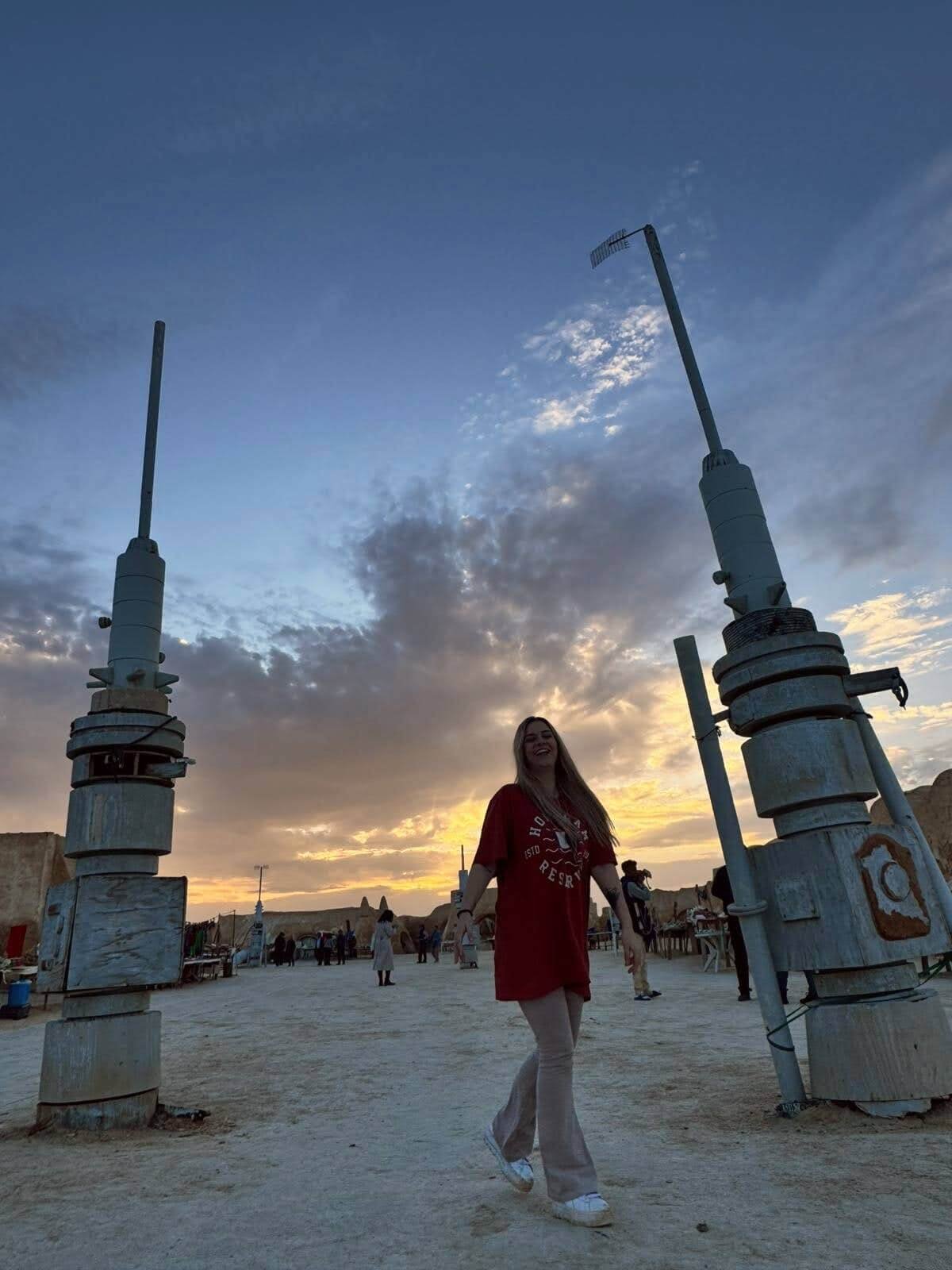
At Mos Espa, you’ll also find souvenir stalls, places to buy snacks (try bread baked underground and smothered with spicy harissa), Arabic coffee (also heated in the ground), and various desert activities, such as camel riding or quad biking over the dunes.
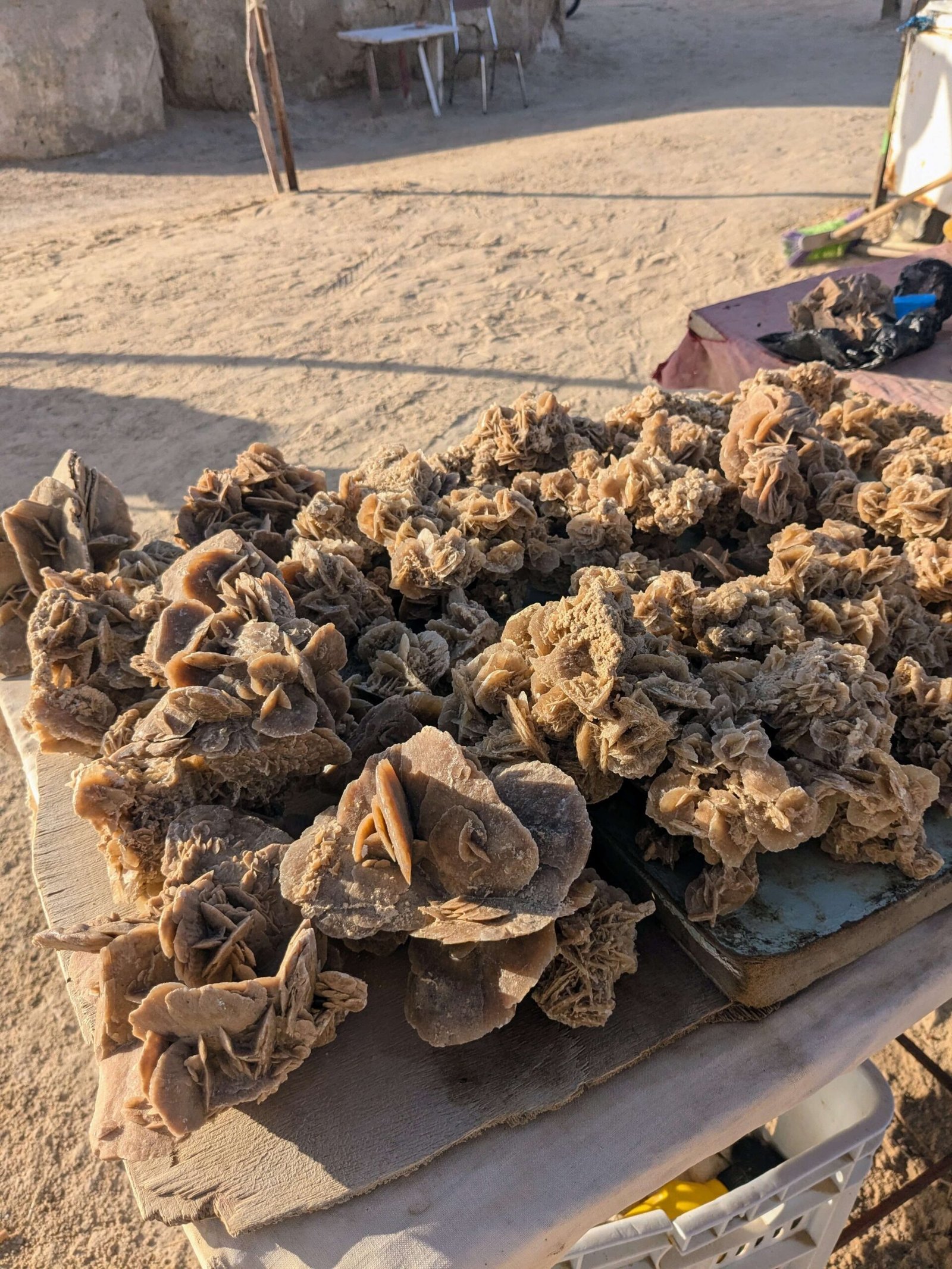
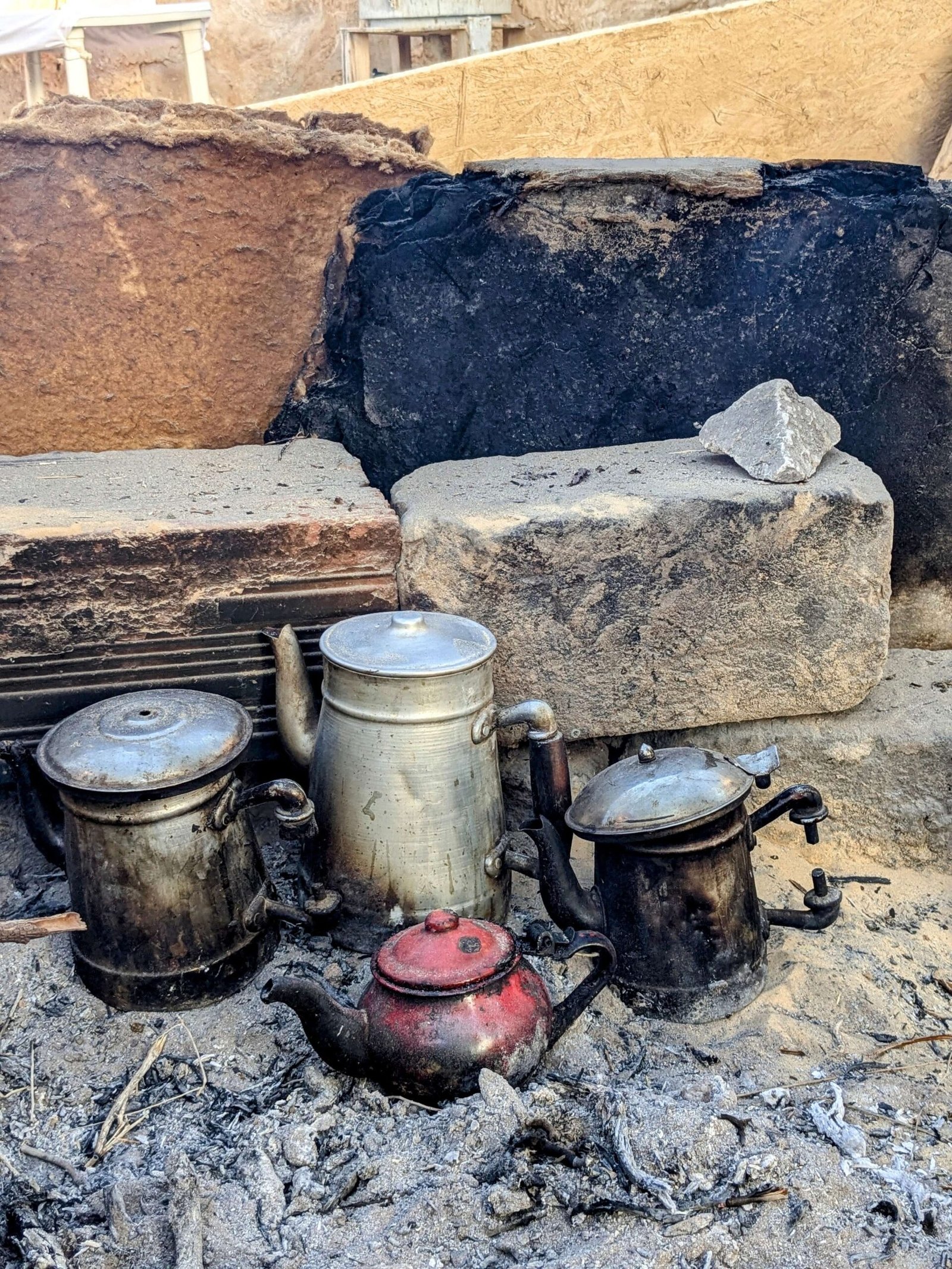
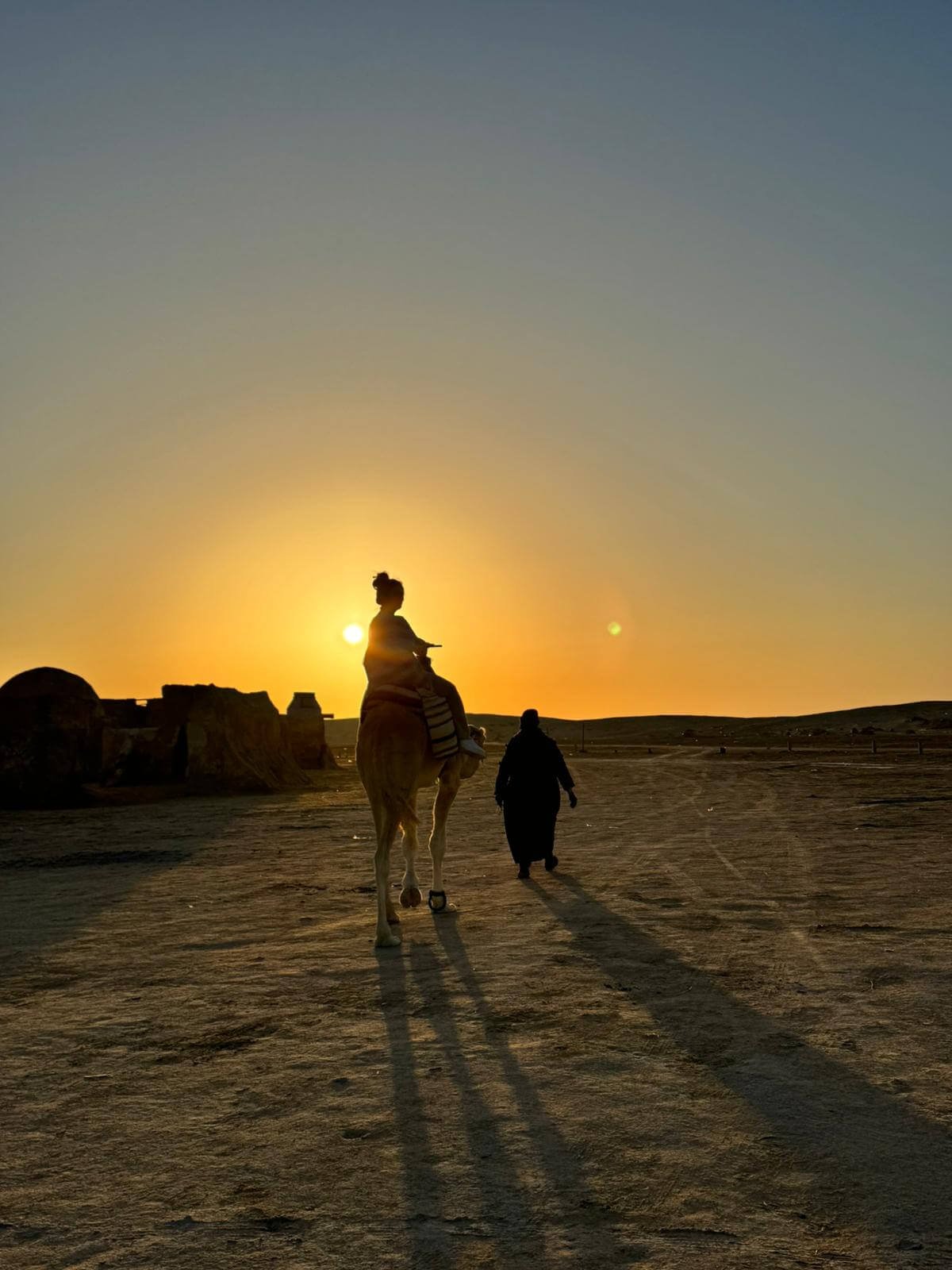
On the ride back, pass by Ong Jmal (‘Camel Neck’ in Arabic), a striking rock formation in the desert that was also a Star Wars filming location.
Also nearby is a filming location from the historical drama series Kingdoms of Fire, which depicted the struggle between the Mamluk Sultanate and the Ottoman Empire.
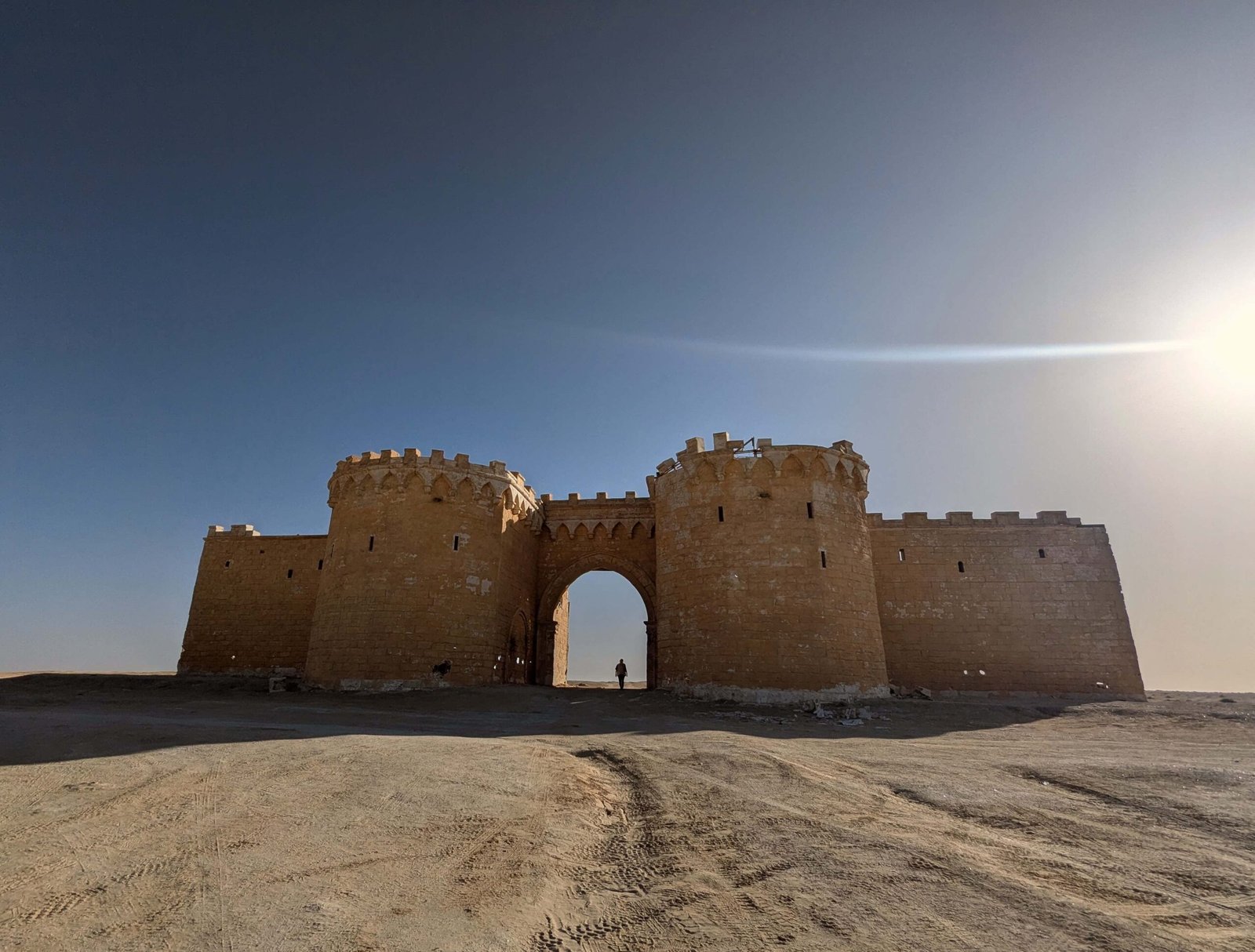
Day 5: Tozeur to Sousse (via El Jem)
Have a big breakfast because you have another long day of driving today!
Morning: Drive to El Jem
Just under 5 hours from Tozeur is El Jem Amphitheatre (also spelt El Djem), a UNESCO World Heritage Site and one of the most impressive Roman amphitheatres in the world.
Built in the 3rd century AD, it could seat up to 35,000 spectators, showcasing the power and wealth of ancient Thysdrus (modern-day El Jem).
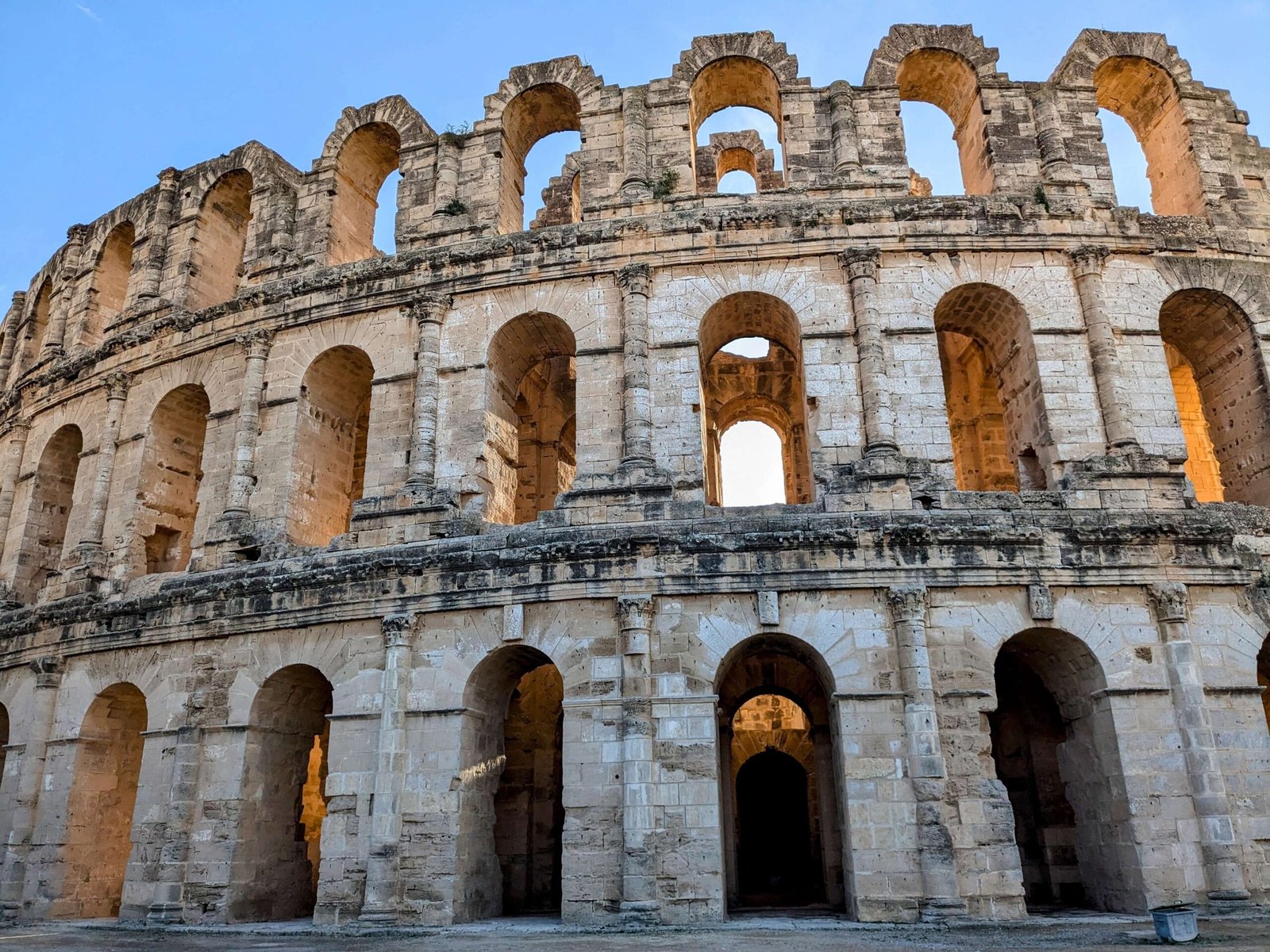
The El Jem Amphitheatre is remarkably well-preserved, allowing visitors to climb all the way to the top for panoramic views of the surrounding town, as well as wander the arena floor for a gladiator’s perspective.
Take some time to explore the amphitheatre’s massive stone arches and underground chambers, where gladiators and animals were once held before battles.
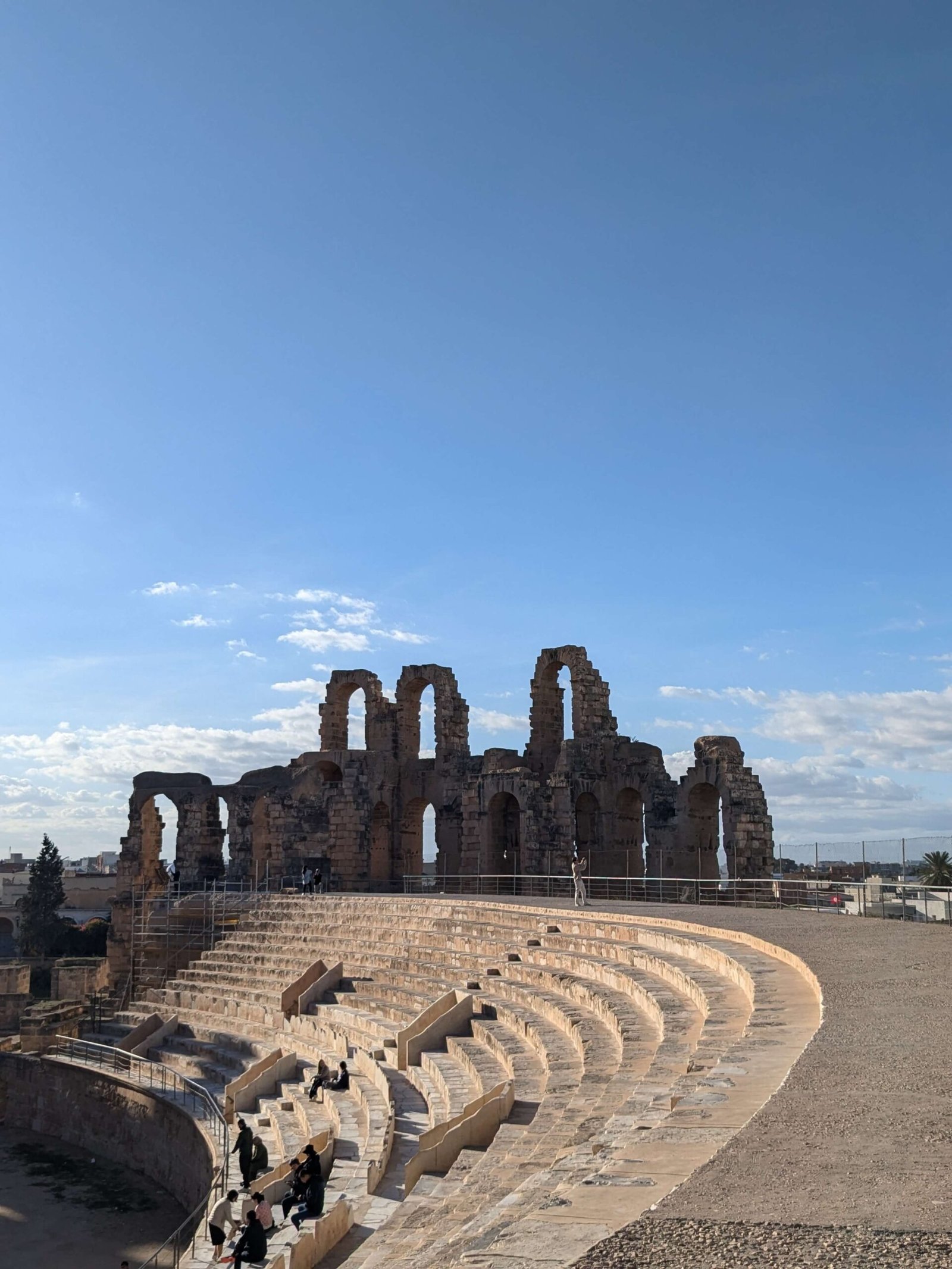
Need to know:
- Entry costs 12 TND (£3), which also grants access to the El Djem Archaeological Museum nearby.
- The museum houses mosaics and artifacts from Roman Thysdrus, offering deeper insight into the region’s history.
- Across the street from the amphitheatre is a really pretty souvenir shop, with reasonably-priced goods. I loved this shop, and definitely recommend paying a visit!
- Just before you get into the city of El Djem, you’ll pass Hotel Resto Dar Ammar (Google Maps link). This is where we stopped for lunch, and it was pretty good.
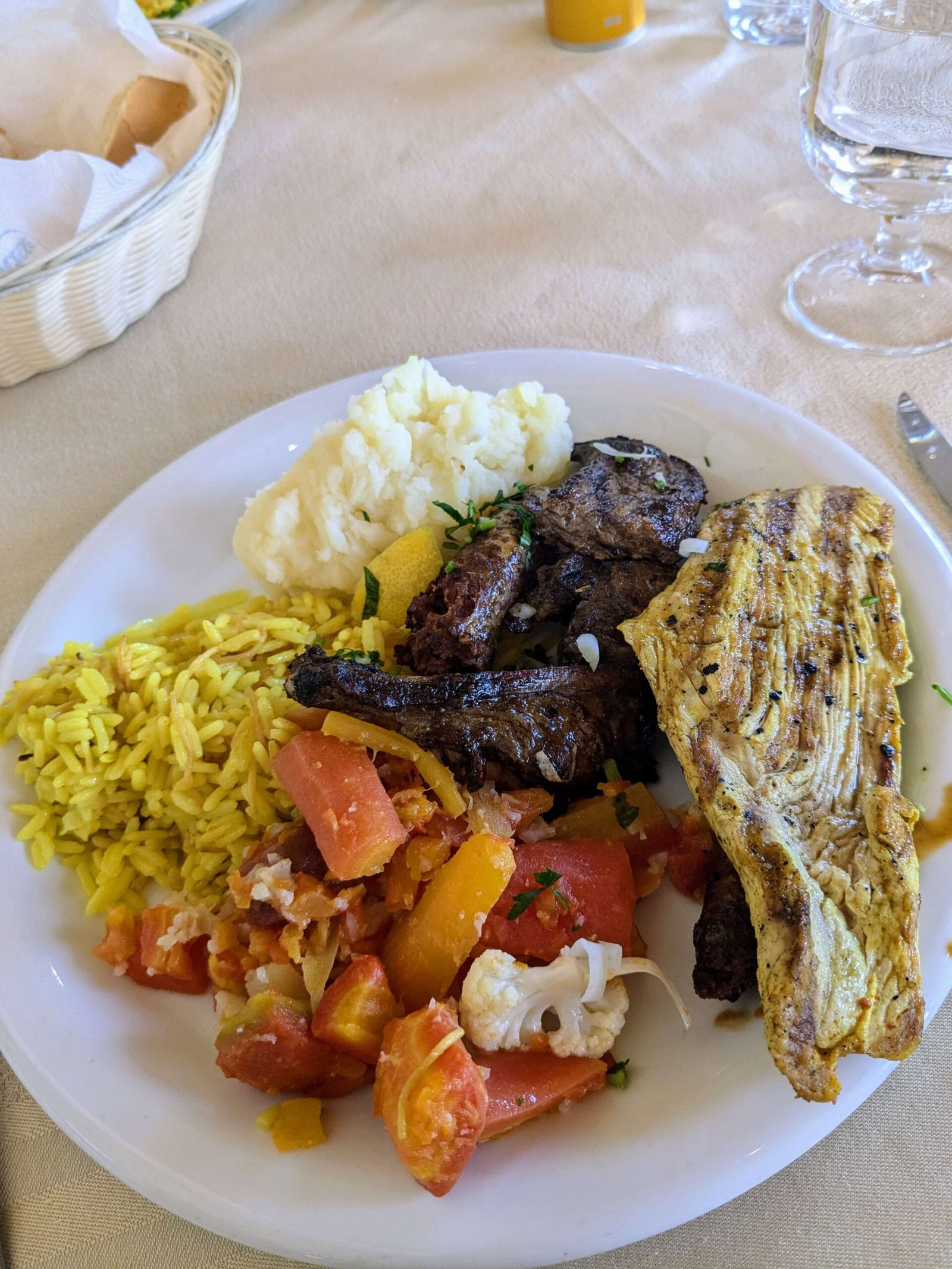
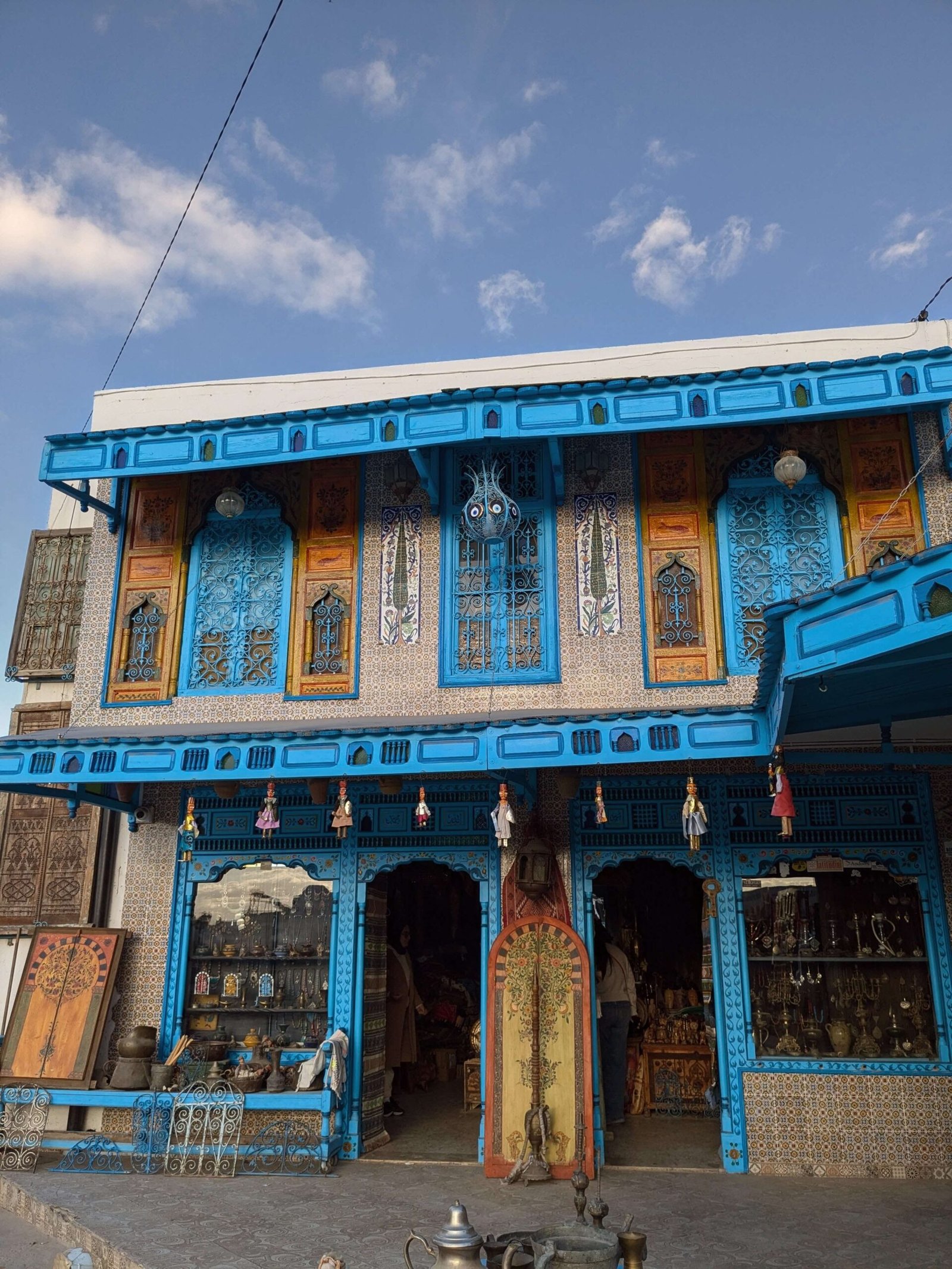
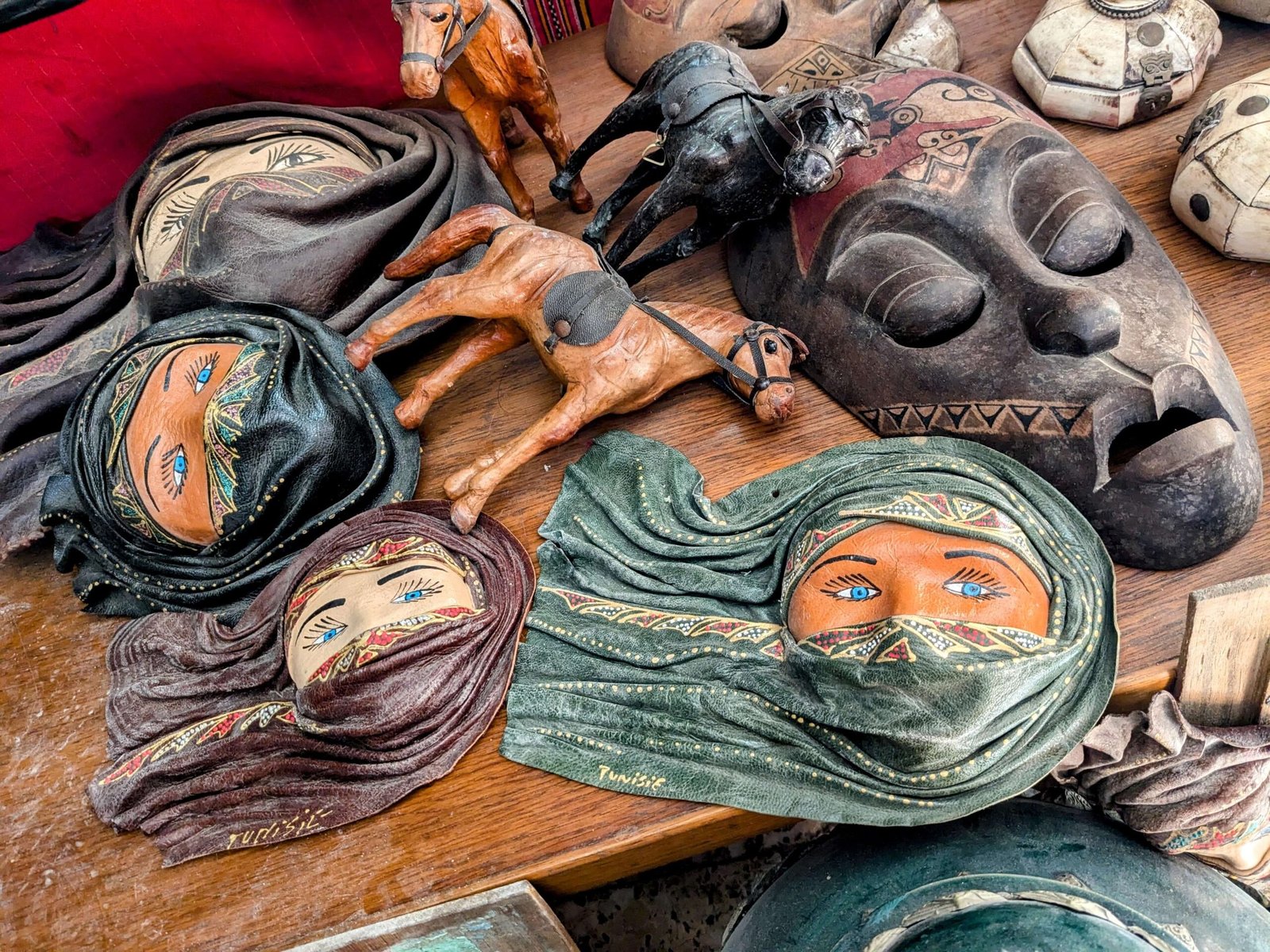
Afternoon: El Jem to Sousse
Just over an hour away from El Jem is Sousse, where you’ll be staying the night.
Check into your hotel in the late afternoon, and spend the evening relaxing.
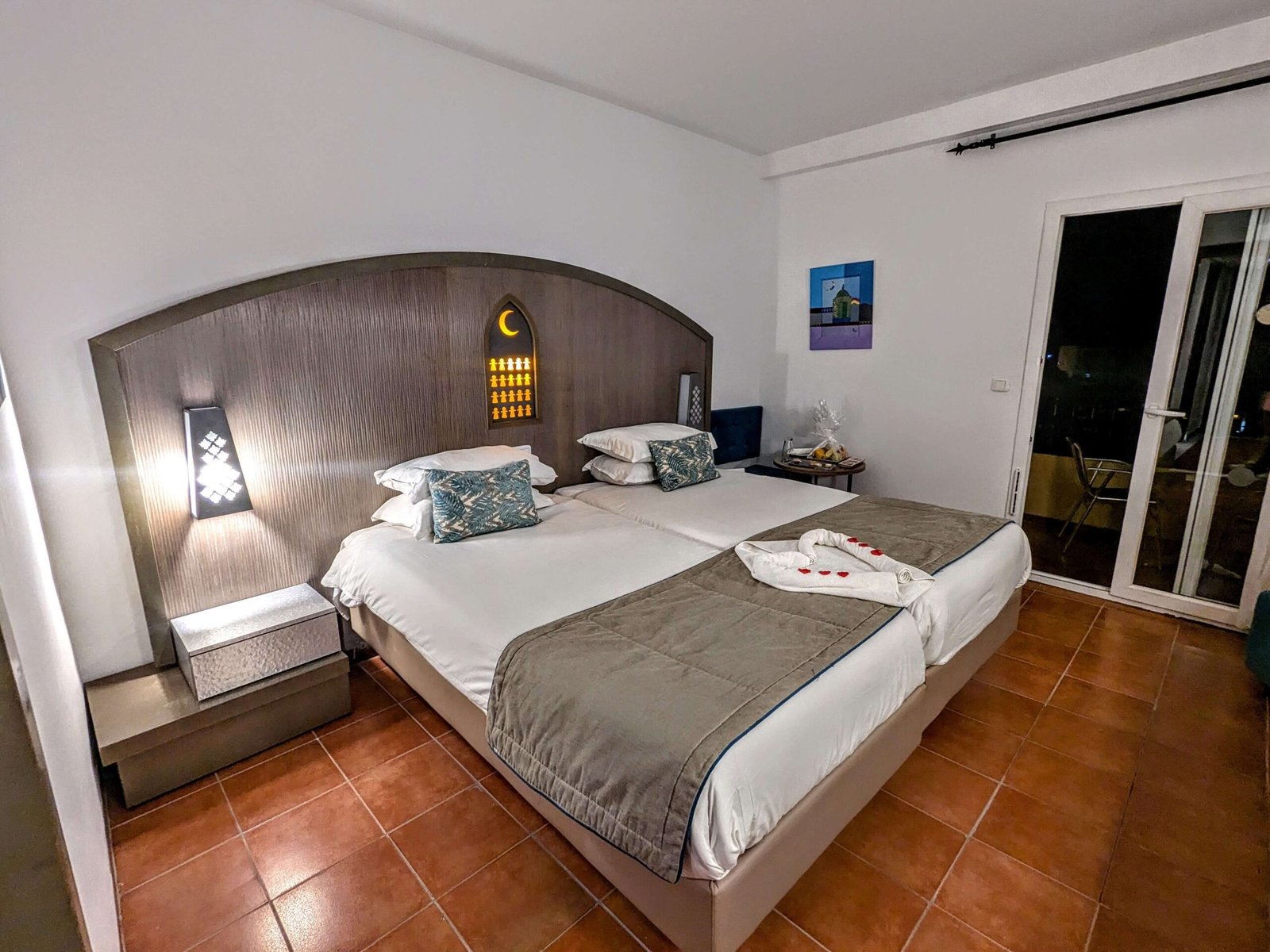
Where to stay in Sousse
We stayed at the 4-Star Royal Kenz, which I can’t recommend enough.
Not only does it have a spa, but it’s also home to 4 restaurants (the food at this hotel was the best I had in Tunisia), 4 bars, 2 pools, and a private beach.
I particularly enjoyed the traditional music (and belly-dancing!) in the evening.
Day 6: Sousse and Sidi Bou Said
Morning: Explore Sousse Medina
The UNESCO World Heritage Site of Sousse Medina is surrounded by majestic city walls that date all the way back to the 9th century.
Wander the labyrinthine streets, picking up some souvenirs, trying local street food, and petting the adorable stray cats before heading to the Ribat of Sousse, a 9th-century fortress-monastery with a watchtower offering stunning views of the city and the Mediterranean Sea.
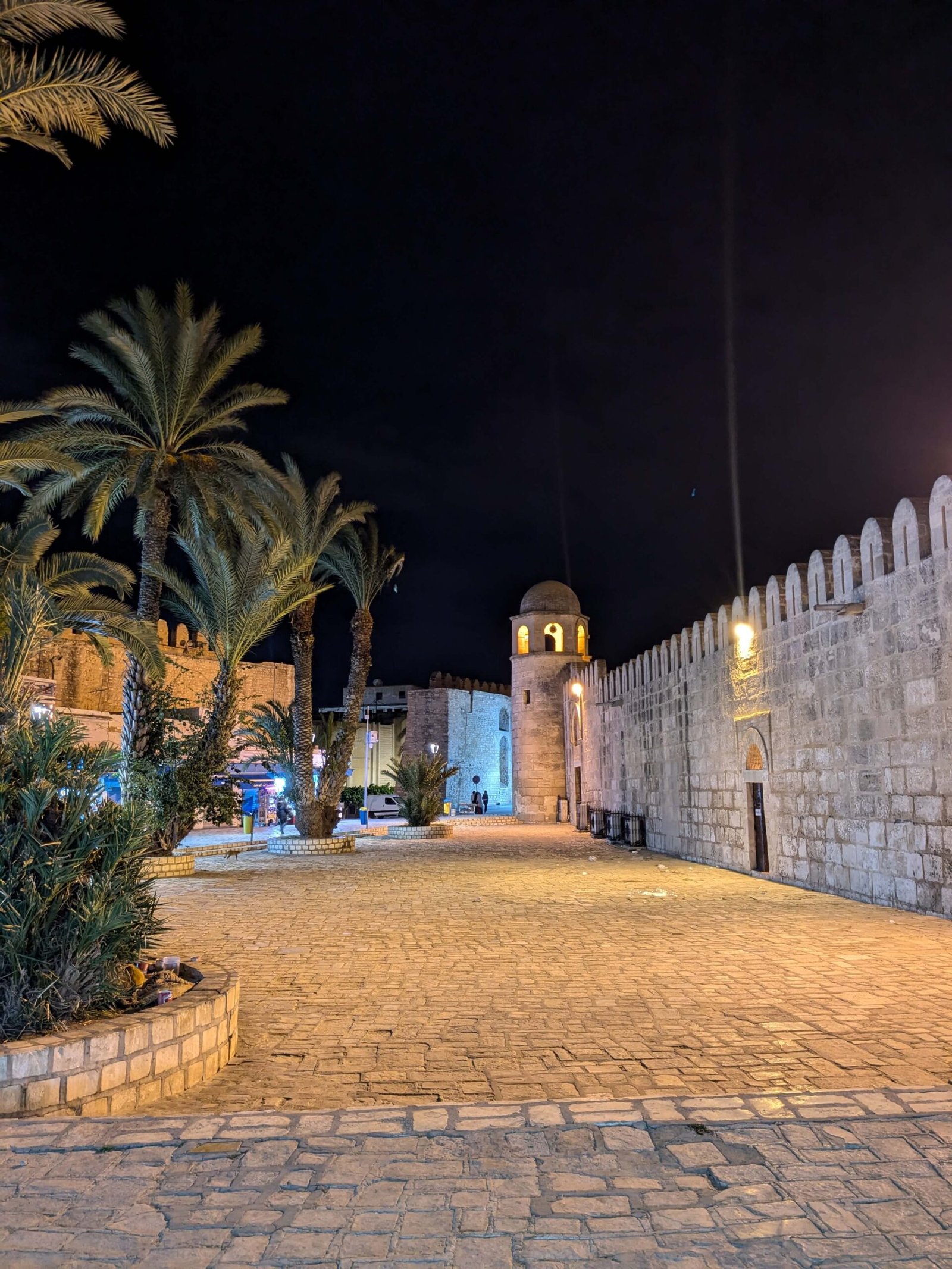
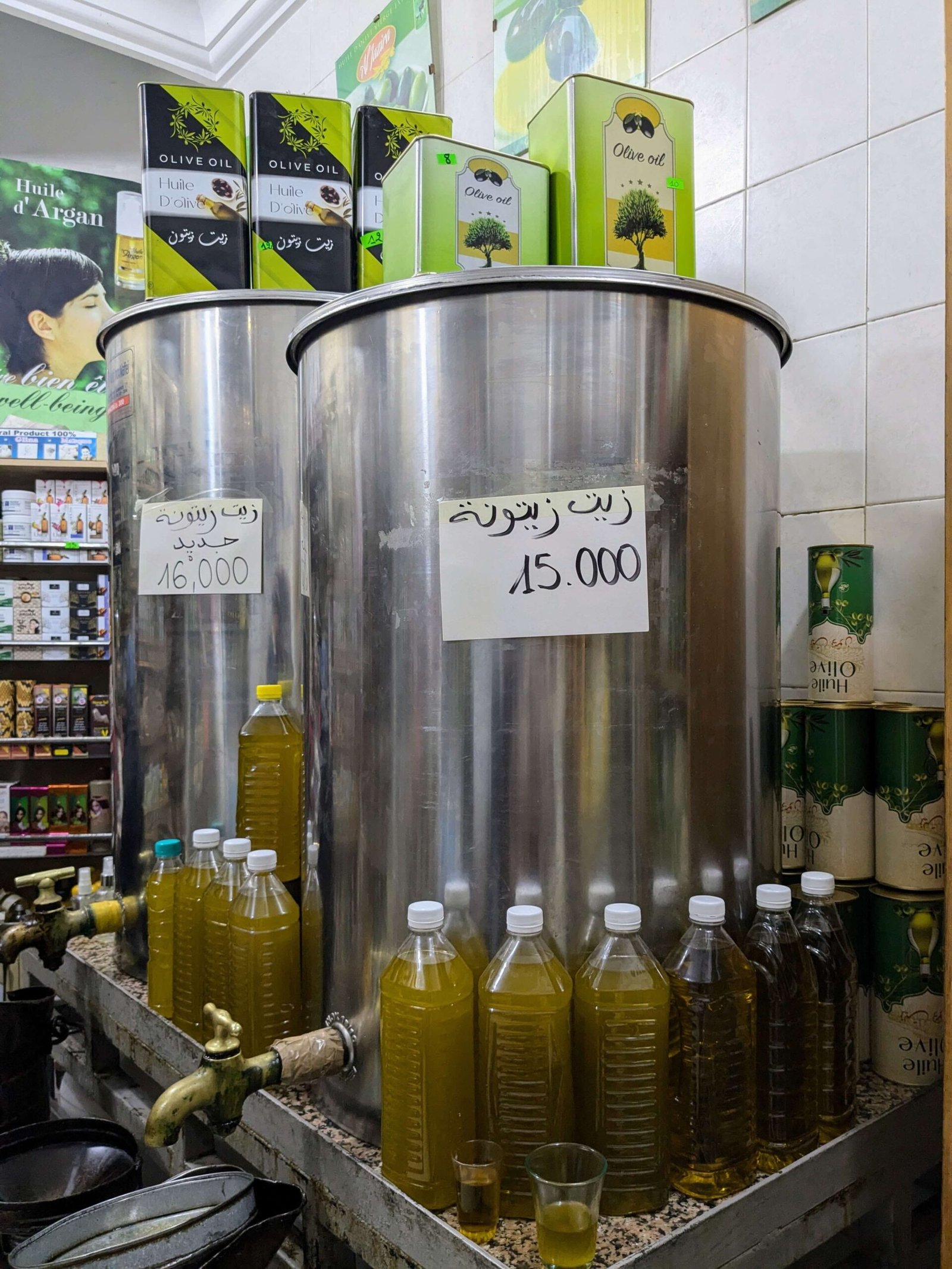
Need to know:
- Entry to the Ribat of Sousse costs 8 TND (£2), with an additional 1 TND (25p) fee for photography.
- If you have time, the Sousse Archaeological Museum, located near the Medina, is worth a visit for its impressive collection of Roman mosaics.
Afternoon: Sidi Bou Said
One of my favourite places in Tunisia was the picturesque village of Sidi Bou Said, conveniently between Sousse and Tunis.
Perched on a hill overlooking the Mediterranean, Sidi Bou Said is very touristy, but for good reason.
With its blue-and-white architecture, Sidi Bou Said feels more like a Greek island than a Tunisian village, and it’s impossible not to fall in love with.
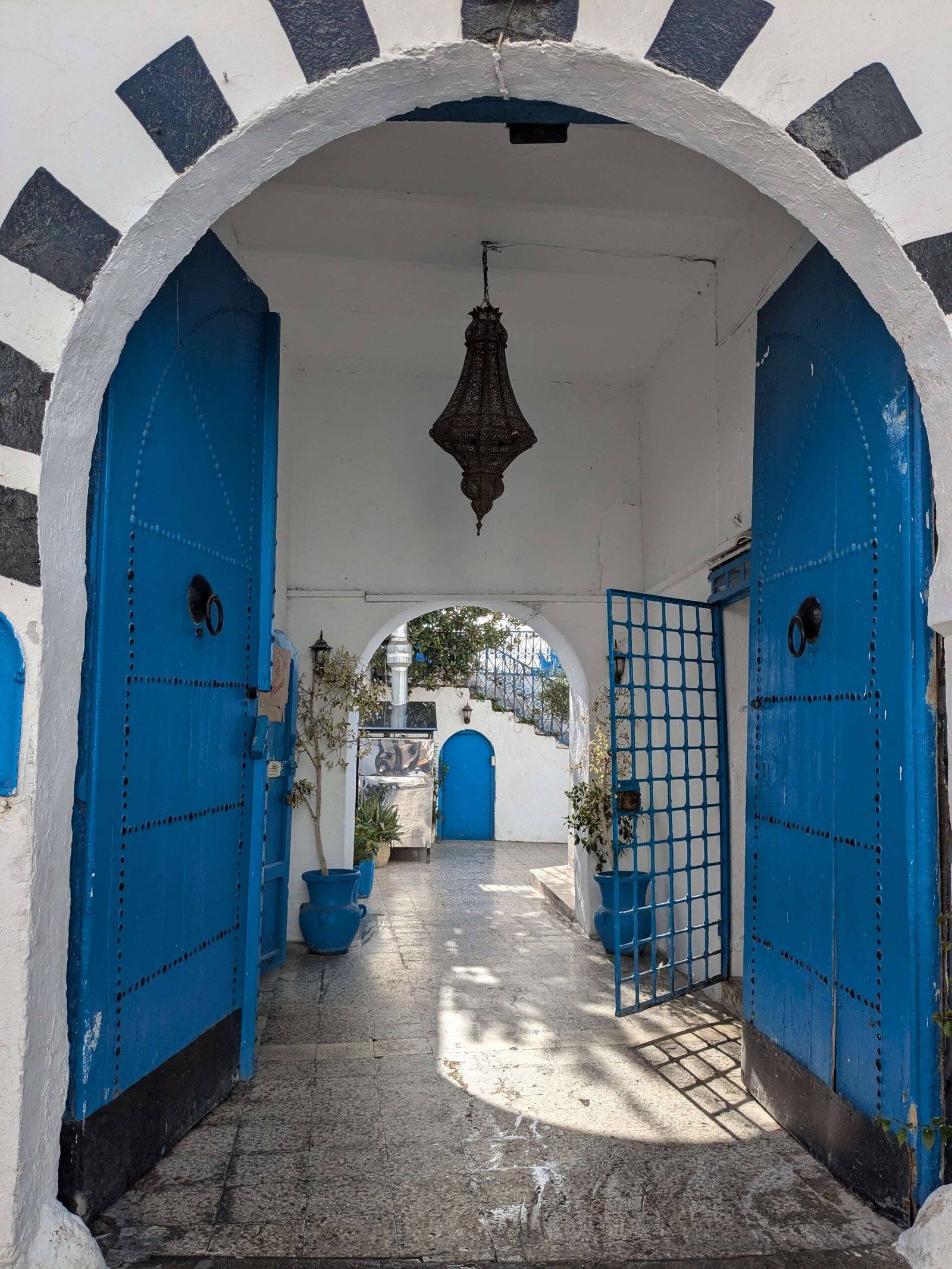
My best tip would be to turn down an alleyway and lose the crowds. Sidi Bou Said can get very busy, but most tourists never stray away from the main walking street.
A nice place to enjoy a mint tea and watch the world go by is Art Café (Google Maps link).
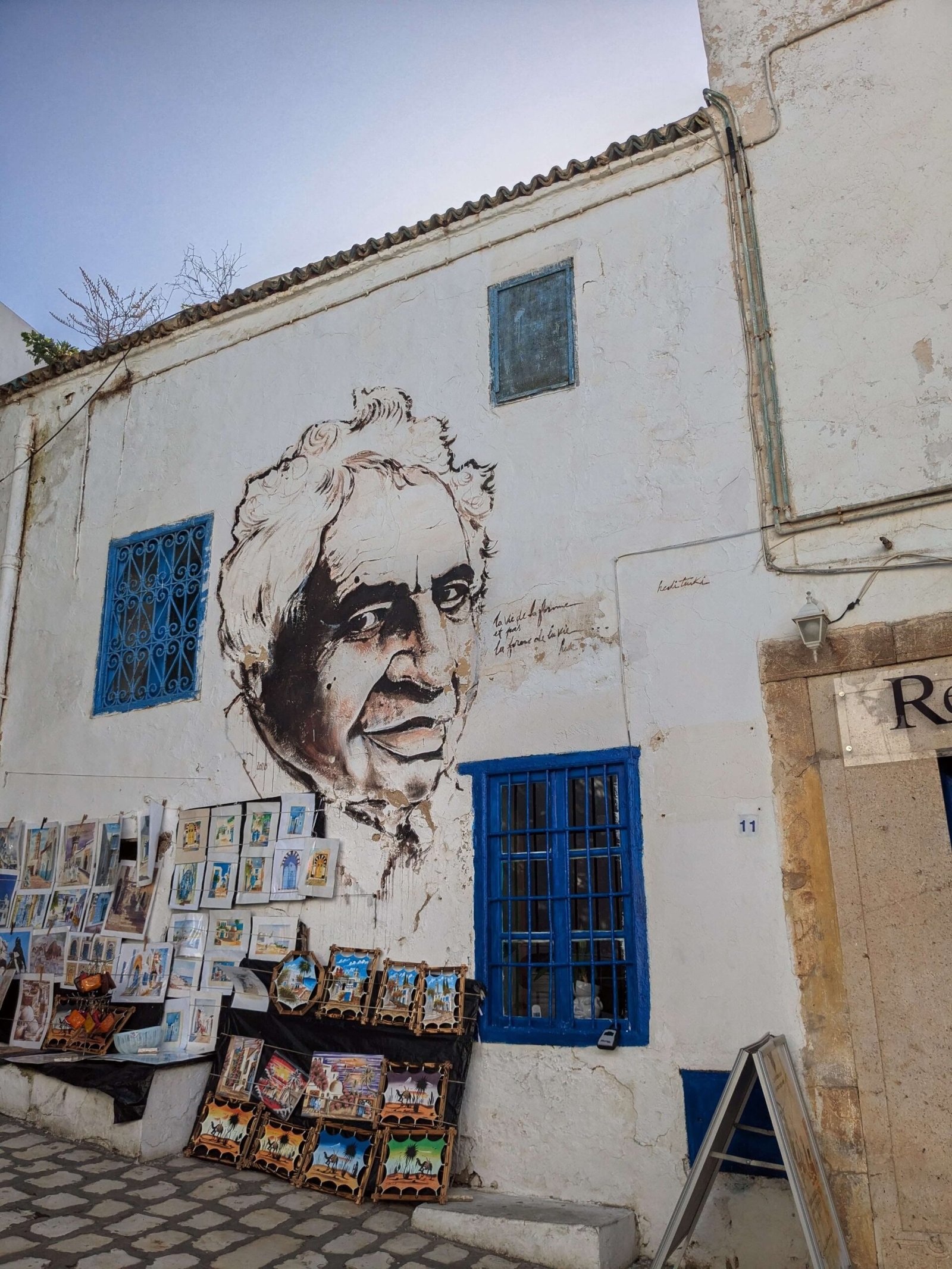
Before you leave, treat yourself to a bambalouna.
Sidi Bou Said is famous for this sugary treat, which is essentially is a deep-fried doughnut, served piping hot and dunked in sugar. Bambalouni cost between 1-2 TND (25-50p) from the little cafes and stalls dotted around town, so you can’t afford not to try one!
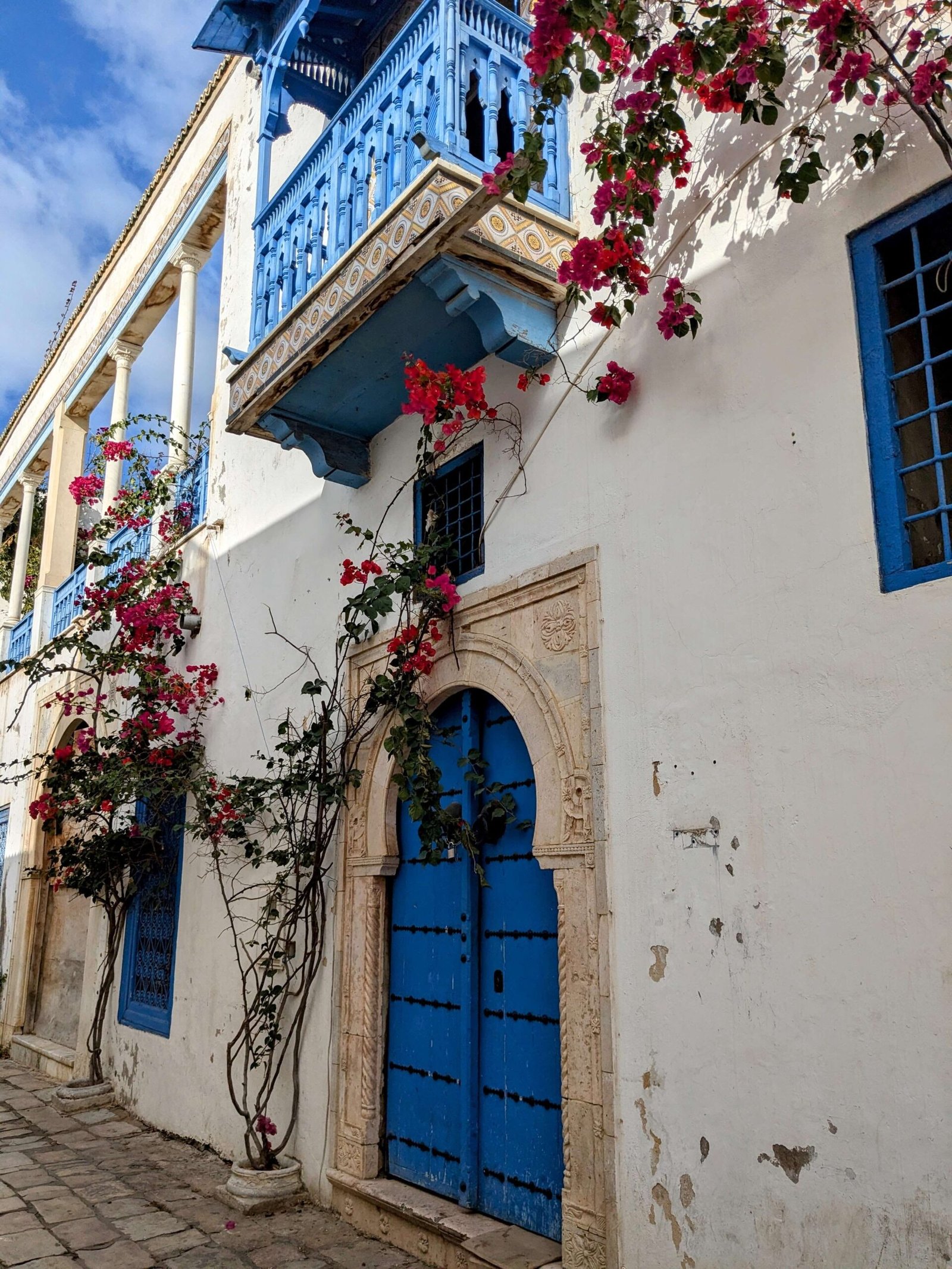
Evening
For your last night, you can either head back to Tunis, or spend the night in Sidi Bou Said.
Personally, I would stay in Sidi Bou Said, because touristic places such as this tend to get much quieter in the evenings, and you’ll be able to appreciate the village even more. There’s also lots of seafood restaurants here with gorgeous sea views.
I didn’t spend the night in Sidi Bou Said so can’t recommend any hotels in particular, but here are the highest rated accommodation options on Booking.com.
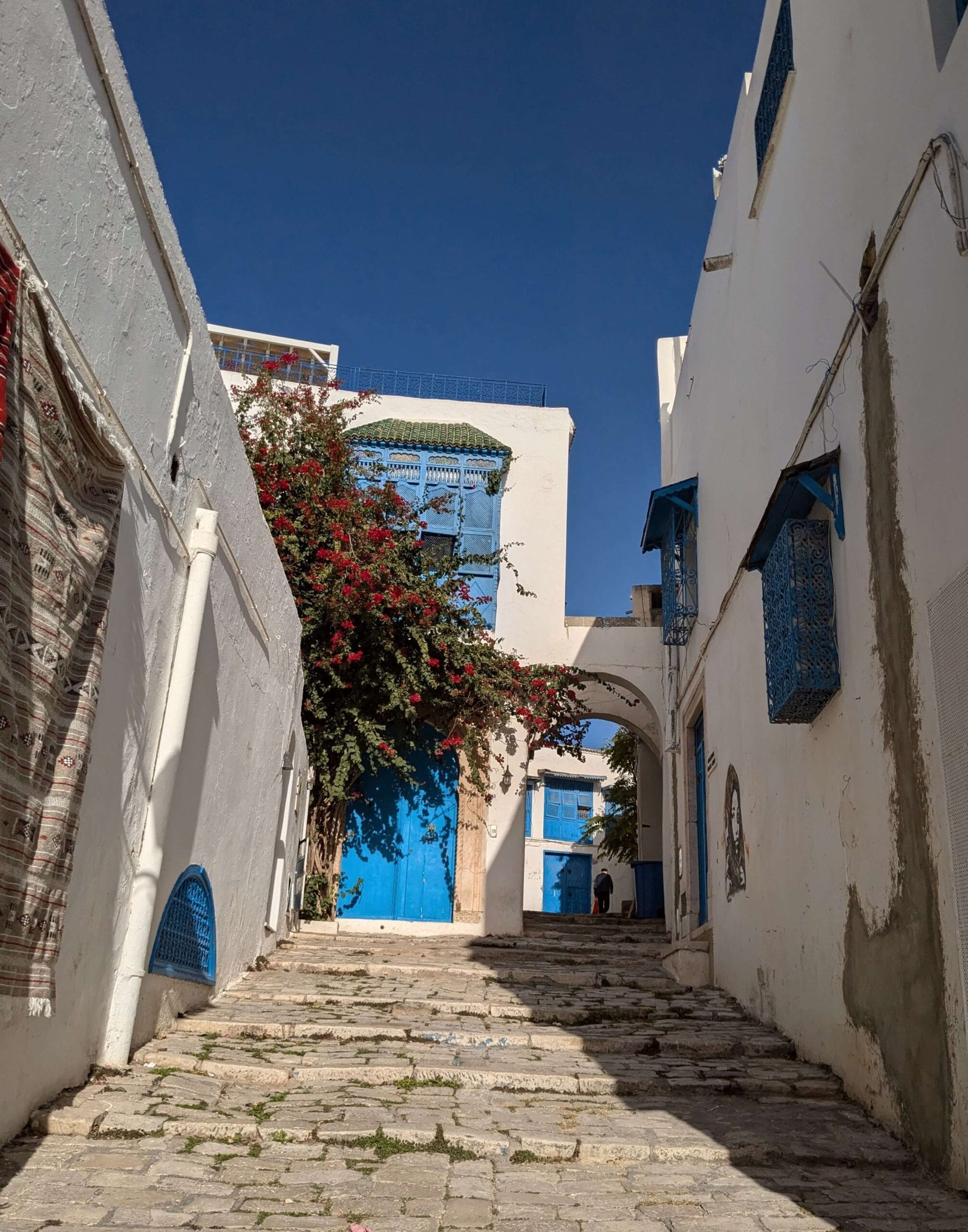
Day 7: Carthage and departure from Tunis
The ancient city of Carthage, another (!) UNESCO World Heritage Site, is the perfect final stop on your way back to Tunis from Sidi Bou Said.
Once the centre of the powerful Carthaginian Empire, Carthage is now a fascinating archaeological site that offers a glimpse into Tunisia’s ancient history.
Start at the Byrsa Hill, where you’ll find the Carthage National Museum and remnants of Punic and Roman structures, including residential ruins and cisterns.
From there, visit the Antonine Baths, one of the largest Roman bath complexes ever built, situated right on the coast with stunning sea views.
Need to know:
- Entry to the Carthage ruins costs 12 TND (£3), which covers multiple sites, including the Byrsa Hill, Antonine Baths, and the Punic Ports.
- Allow at least 2–3 hours to explore the main highlights, but be prepared for some walking between sites.
And that brings us to the end of your trip!
Depending on what time your flight is, either head straight to Tunis airport from Carthage, or back to the city for any last-minute shopping (and mint tea!).
Is Tunisia safe?
Yes, Tunisia is safe!
As you would anywhere, it’s important to stay vigilant and aware of your surroundings, but Tunisian people are very hospitable and will often go out of their way to help tourists.
If you’ve spent any time travelling in Morocco or Egypt, you will find Tunisians to be a lot more reserved and laid back, and the overall travel experience here is calmer and less chaotic.
As a female traveller, I did not experience any harassment in Tunisia, and none of the women that I have spoken to have had negative experiences in Tunisia either.
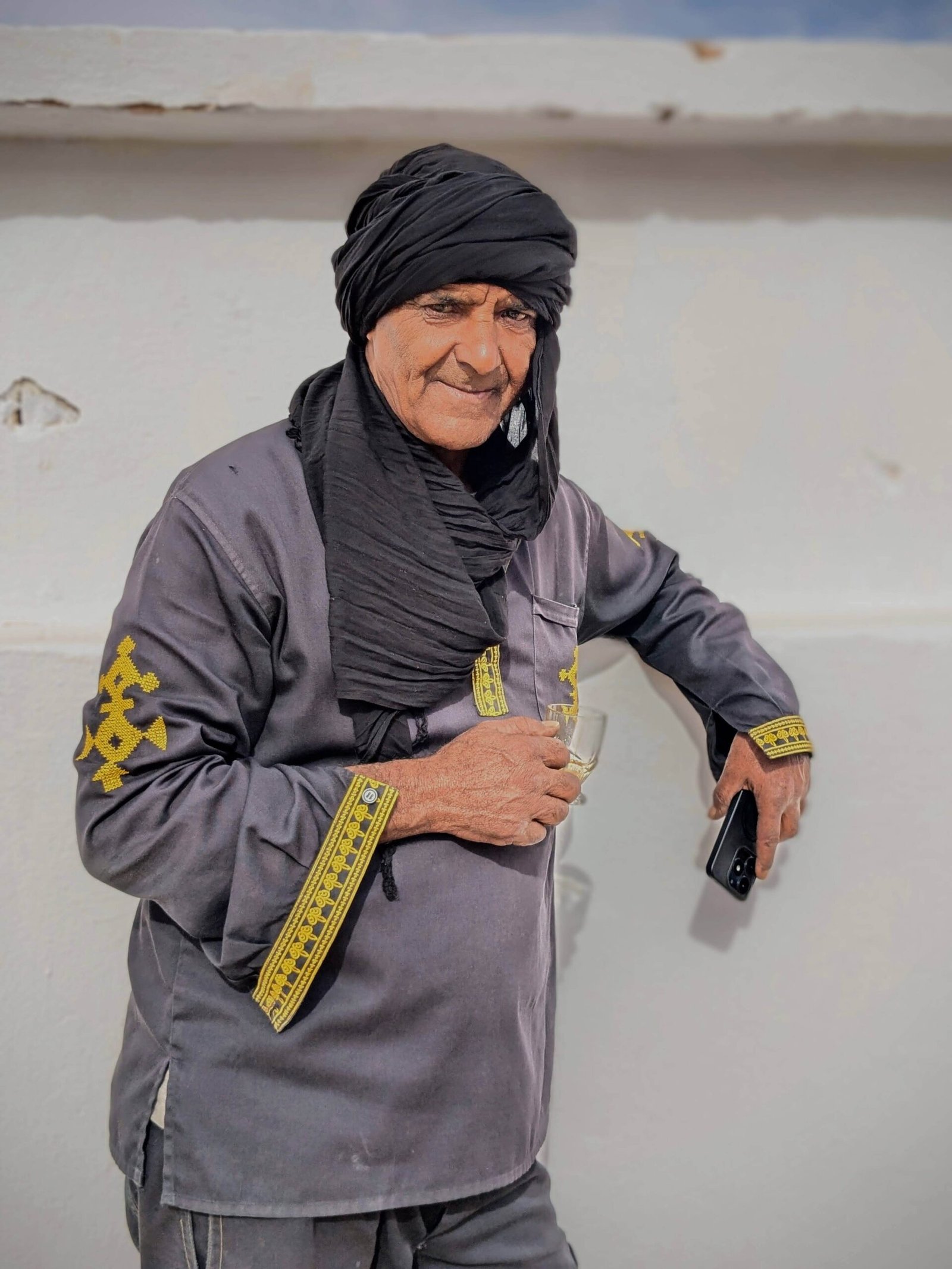
When it comes to the current situation regarding Israel, Tunisia is actually further away from Israel than Sicily, meaning that it is not geographically affected by the situation.
With that being said, the UK Foreign Office updated its advice in October 2024, saying ‘Ongoing hostilities between Israel and Lebanon could escalate quickly and pose risks for the wider region. Monitor this travel advice and other media as the situation is changing fast.‘
It’s important to keep checking official government advice, but also be cognisant of the fact that government advice always errs on the side of caution.
Best time to visit Tunisia
I visited Tunisia in December, and while it certainly wasn’t beach weather, it was still lovely and sunny while I was there, and most historical sites I visited were empty (which was a definite plus).
For warmer weather but thinner crowds, the best time to visit Tunisia is during the shoulder seasons (April to early June, and September/October).
During these months, temperatures are warm but not scorching, making it ideal for exploring historical sites like Carthage and El Djem, wandering medinas, or hiking in oases like Chebika.
1 Week in Tunisia | Final Thoughts
So, there we have it, the perfect itinerary for 1 week in Tunisia!
I absolutely loved my first visit to Tunisia, and I know for a fact that it will be a place I’ll return to, time and time again.
With delicious food, welcoming people, stunning landscapes, and a fascinating culture, there’s nothing not to love about Tunisia!
That’s all I’ve for you today, but as always, if you have any questions then please leave them in the comments section below and I will get back to you!
Until next time,
XOXO
If you liked this article and would like to support my work, please click the button above to donate a couple of bucks and buy me a coffee. The ad revenue that I receive on this website is minimal, so support from my readers enables me to keep creating content that you (hopefully!) love to read.
Disclaimer: I visited Tunisia as a guest of the TNTO (Tunisian National Tourism Office. I was under no obligation to speak positively about the country, and all opinions in this article are my own. This article also contains affiliate links, meaning that if you book a tour/hotel that I recommend, I may make a small commission at no extra cost to you.
